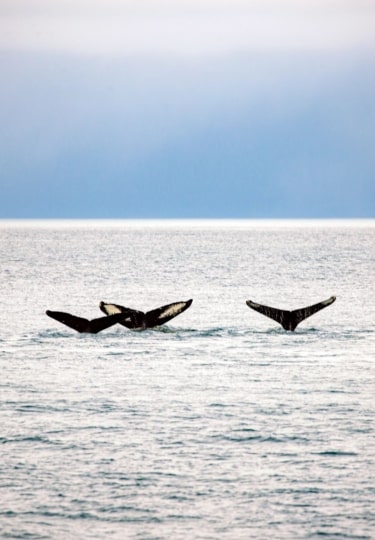Whale watching in Alaska is one of the most joyful experiences of any vacation in the 49th state. You could spot feeding humpback whales, orcas swimming in family pods, and gray whales gliding through the water.
The kinds of whale species you’ll encounter while on your cruise largely depends on which region of Alaska you’re visiting. The time of year you go on your trip also has a large impact on the number of whales you may be able to see.
Here are some important tips to make sure your experience of spotting whales in Alaska is as memorable and rewarding as possible.
Things to Know About Whale Watching in Alaska
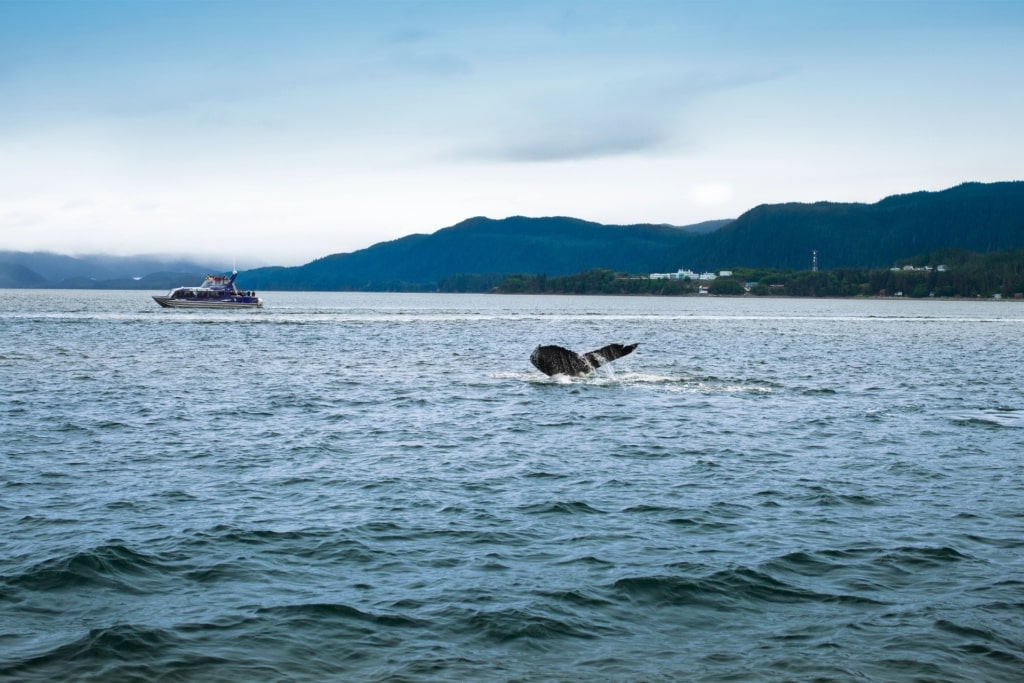
Juneau
The nutrient-rich waters of Alaska are especially attractive to whales, as well as dolphins and harbor porpoises. Spotting these magnificent giants in the wild is a privilege and a real thrill.
Whales are either resident or migratory. There are a few resident pods in Alaskan waters; you could spot the distinctive black-and-white orca in the Inside Passage, for example, where they live year-round.
There’s a resident pod of white beluga whales at Cook Inlet, near Turnagain Arm, which you could be lucky enough to see on the drive from Seward to Anchorage.
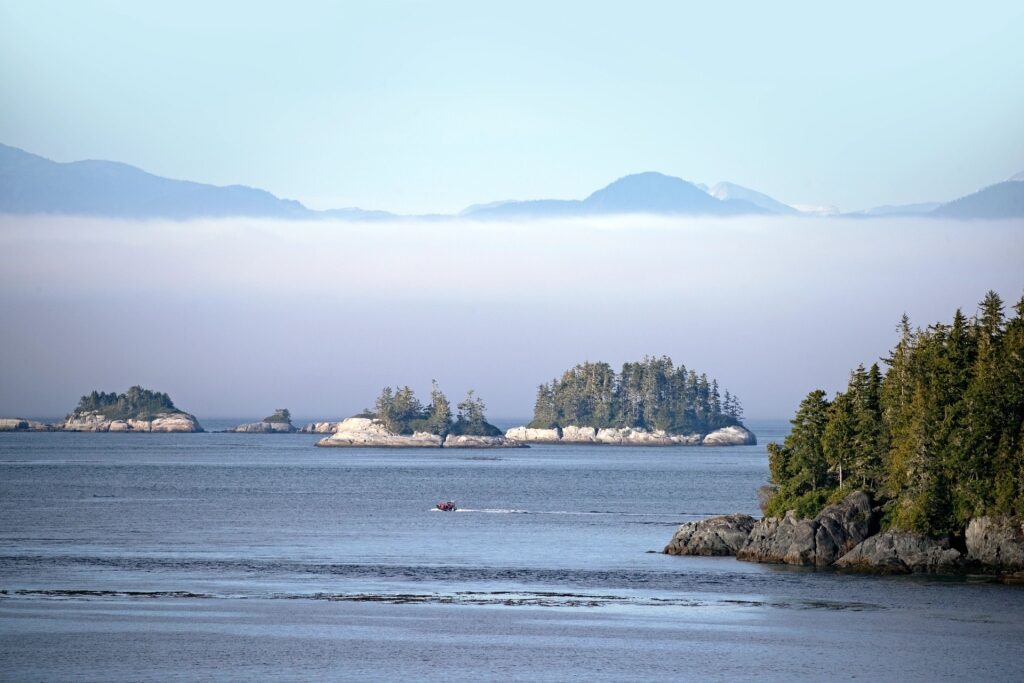
Inside Passage
Other whales arrive in the spring to feed, migrating from the warm waters of Hawaii and Mexico to Alaska, heading back the other way in September. Humpbacks are the most common, spotted all along the Inside Passage and from ports including Juneau, Ketchikan, Icy Strait Point, and Sitka, while you could see gray whales, too.
There are different ways to spot whales. You will most likely see them from a cruise ship, especially as you sail through the sheltered waters of the Inside Passage.
There are places where you can spot marine mammals from land, too; the Tony Knowles Coastal Trail in Anchorage is a strong possibility, as is Whale Park on Sawmill Creek Road in Sitka, a great place to observe humpbacks.
The best way, though, is to take a whale watching excursion. You’ll be escorted by marine mammal experts who know where the whales feed and can explain their different behaviors.
Types of Whales to See in Alaska
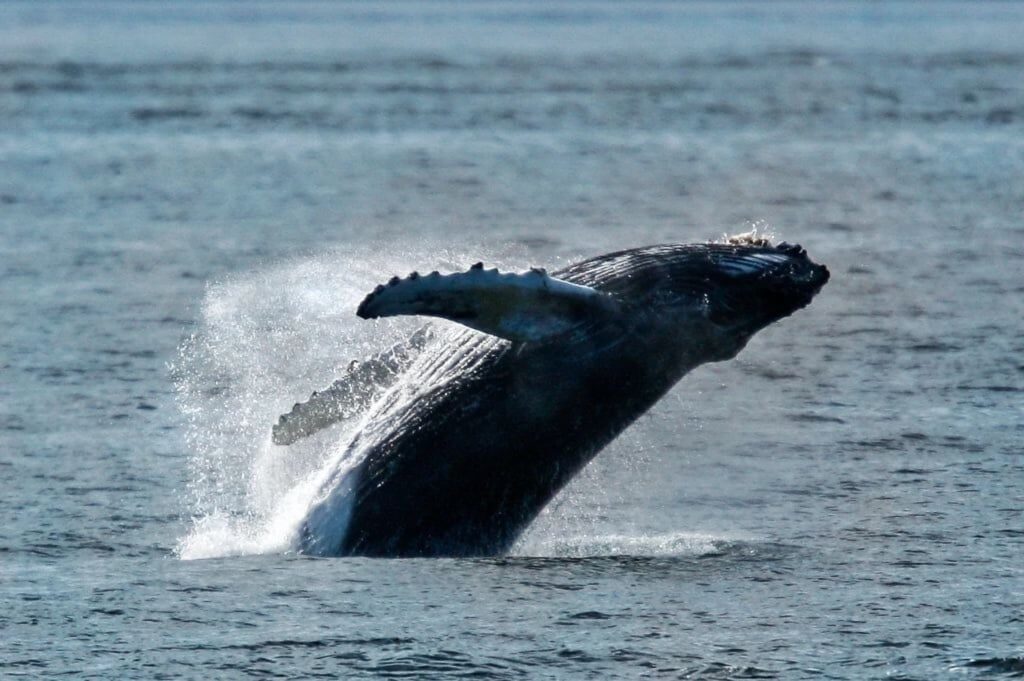
Humpback whale
The most likely sightings will be of humpback whales and orca. You could also spot minke and gray whales around the Inside Passage, although they’re not as acrobatic as the humpbacks. Look for the distinctive white beluga whales around Cook Inlet, too.
Other whale species are more inclined to stay further out to sea, so on a voyage from the Kenai Peninsula, you could be lucky enough to see fin, sei, sperm, and mighty blue whales, the biggest mammal on the planet.
Whale Identification & Behavior
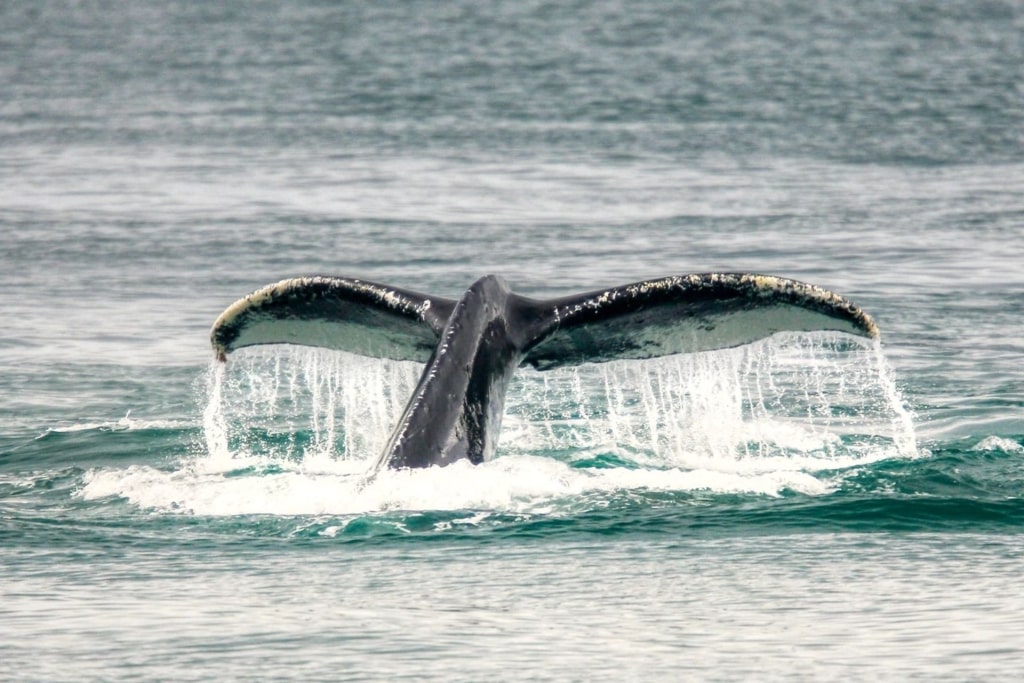
Humpback whale
Different whale species have different behaviors, and learning to interpret these is all part of the fun of spotting whales in Alaska.
Humpback whales are what’s called baleen whales, which means they don’t have teeth but rather multiple fringes of keratin, which is what our hair and nails are made of, that act as a filter.
Females are larger than males, averaging 49 feet in length. They feed on krill and small fish and are usually spotted alone or in small pods.
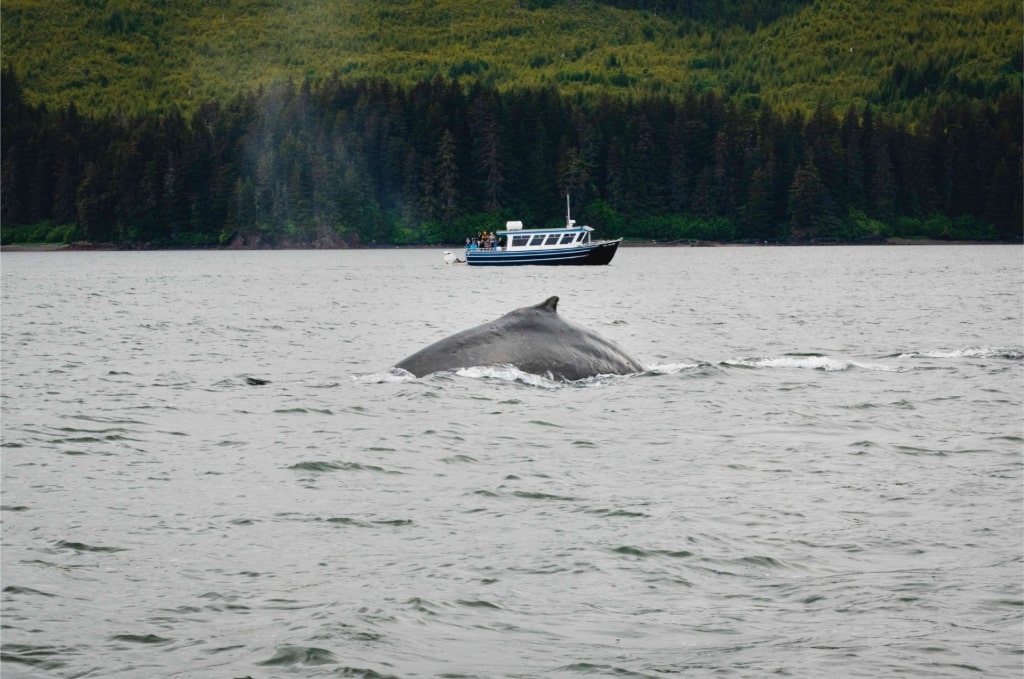
Whale watching in Alaska
Humpbacks are the most active whales. You’ll see them “spy hopping”, which is when the whale’s head pokes vertically out of the water as it checks out its surroundings. They slap their fins and tail flukes on the water as a way of communicating with other whales.
They are expert bubble net feeders. This is when a group of whales blows bubbles to disorientate its prey, a shoal of fish, for example, and then swims around underneath it in circles, lunging dramatically to the surface and scooping up a large mouthful in the process. Humpbacks breach, too, leaping right out of the water and landing with an almighty splash.
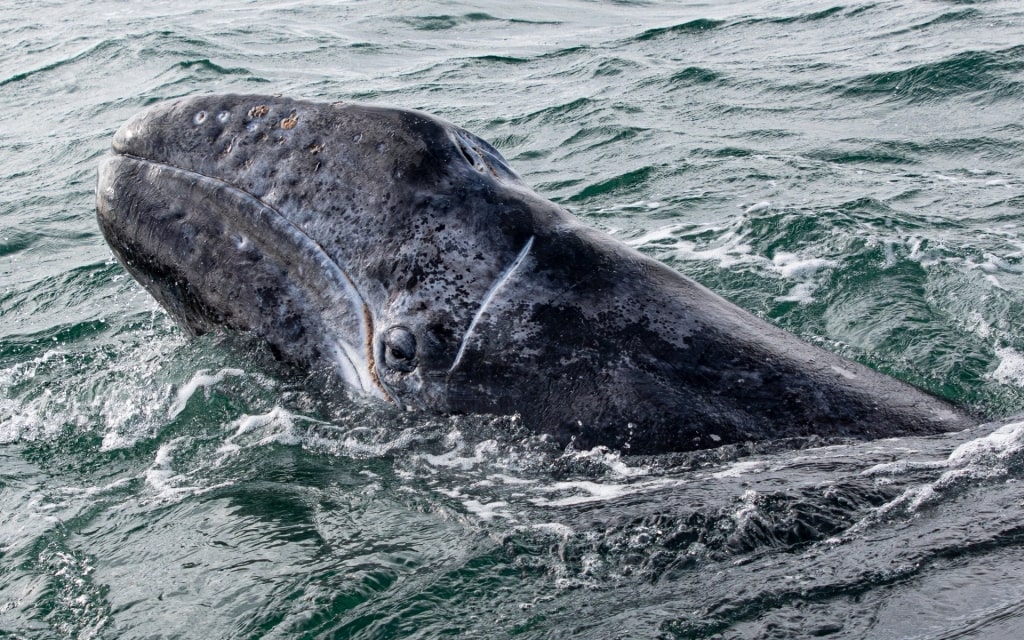
Gray whale
Gray whales are also baleen whales, slightly smaller than humpbacks. They don’t have a dorsal fin, which is one way of telling the difference. They feed mainly on crustaceans found on the sea bed and live in small pods. They’re not as active as humpbacks, but you could spot them spy-hopping and breaching.
Beluga whales are small, white, toothed whales, only growing up to around 15 feet long. They feed on fish, octopus, squid, crab, and other sea creatures and often congregate around river estuaries.
The population in Alaska’s Cook Inlet is resident, so the whales hunt under the ice in winter. You can spot them first, because they are white, and second, by the bulbous “melon” on top of their heads.
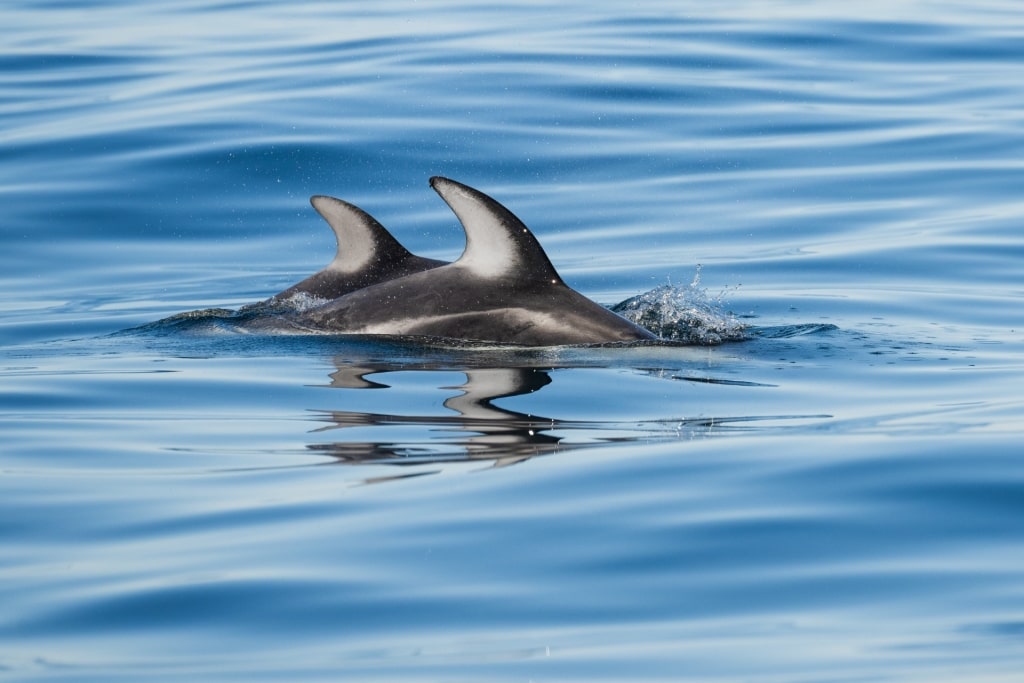
Pacific white-sided dolphins
Pacific white-sided dolphins are much smaller than whales, reaching about seven feet in length, with a dark gray back and pale sides. They feed on fish, swim in large pods and are extremely acrobatic, surfing the waves, leaping right out of the water, and flipping over in somersaults.
Insider Tips for First-Timers Whale Watching in Alaska
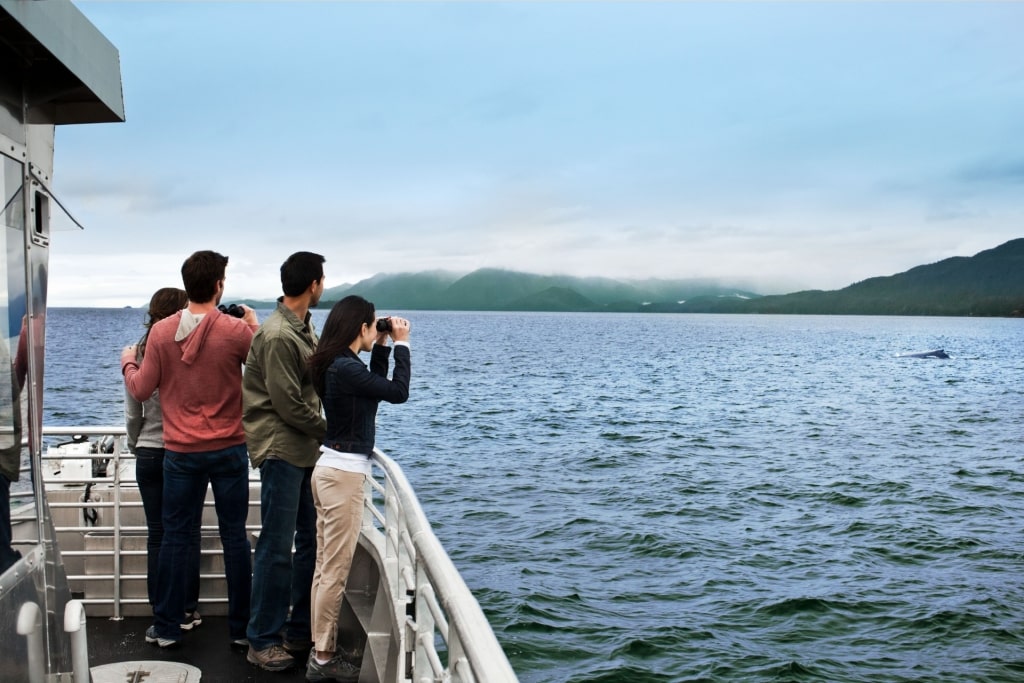
Whale watching in Alaska
The best way to spot whales is on a whale-watching excursion, as the wildlife guides know where the whales are likely to be feeding. However, these are wild animals, and there’s no guarantee that they will make an appearance. If the sea is choppy, they will be harder to spot, too. So you do need to manage your expectations.
You may have to cover quite a distance in your whale-watching boat before there’s any action. Having said this, there is every chance you’ll spot a whale and hopefully, more than one.
A code of conduct binds whale-watching boats, so they won’t get too close to an animal in order to avoid disrupting its feeding or sleeping.
Try to book a tour on a boat with hydrophones, which pick up the haunting sounds of whalesong. It’s thrilling to know that the whales are out there, communicating with one another, even if you can’t see them.
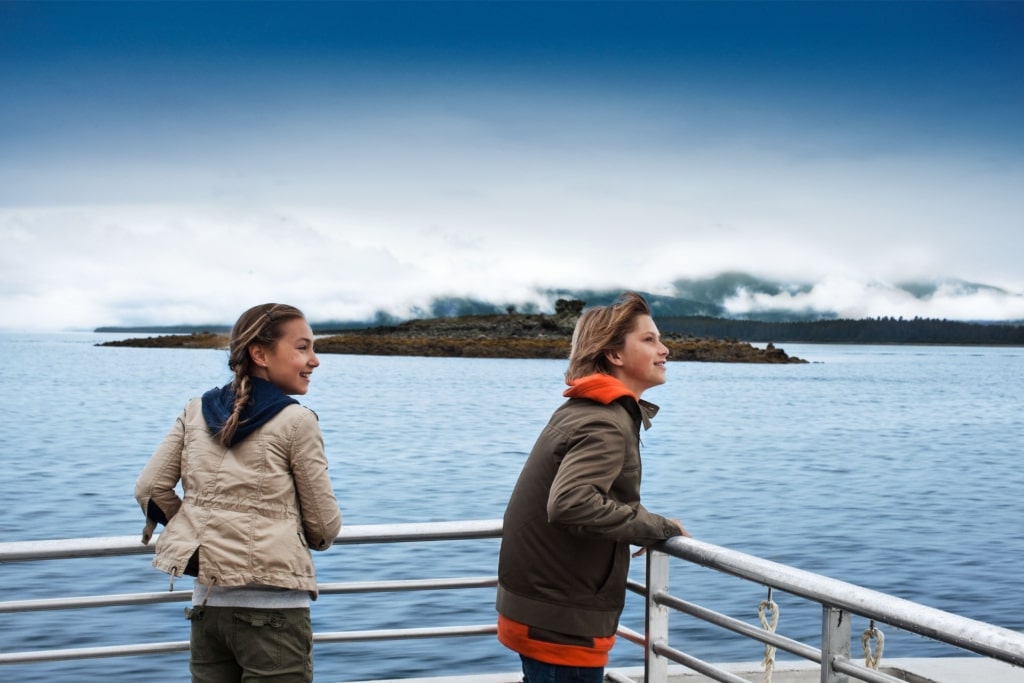
Whale watching in Alaska
If you’re prone to seasickness, choose a whale watching trip on a bigger boat. These tend to be more stable. And dose up before you depart.
The good news is that you’ll be out in the open air, staring at the horizon, which is always a good way to minimize seasickness—and you’ll probably be too excited even to think about it.
Whale watching is one of the best things to do in Alaska with kids. However, if you’re traveling with young children, consider whether a whale watching excursion is right for you. Little kids can get bored easily, and it could be some time before you spot anything.
Young children may also not feel the same thrill as an adult about spotting the spout of an otherwise invisible whale; they’re more excited by animals they can see at close range.
What to Expect on a Whale Watching Excursion in Alaska
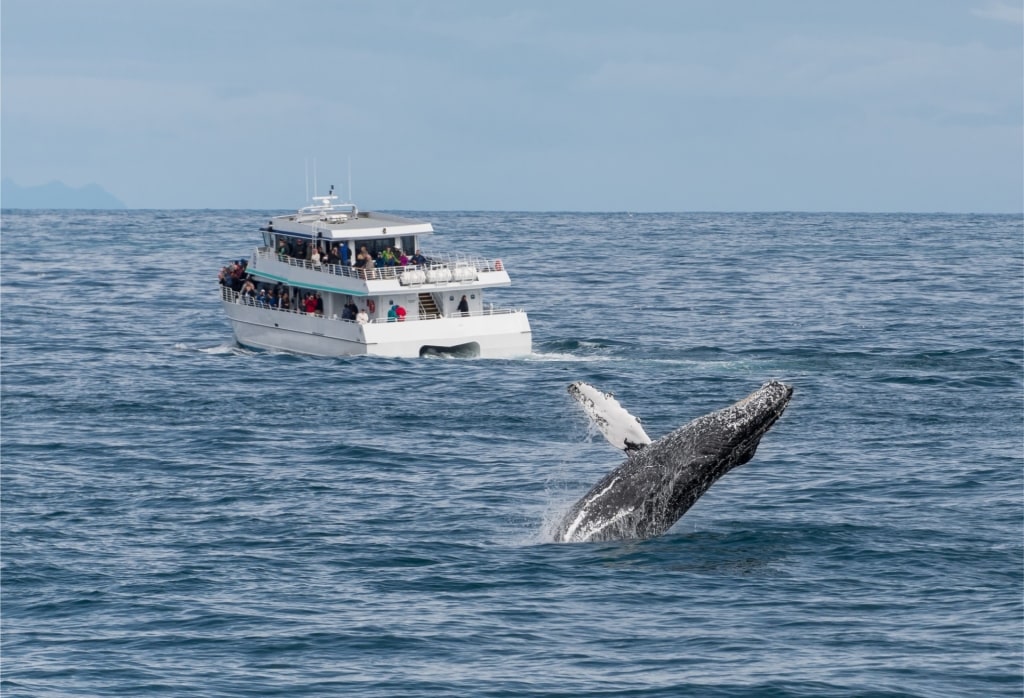
Kenai Fjords National Park
Don’t panic if you see what looks like a lot of people boarding your whale watching boat; there will be space for everybody, and everybody will have a view, even with the excitement of the first sighting. Numbers are limited, in any case, to provide the best experience for everybody.
If other boats are around, your wildlife guides will communicate with their colleagues on other vessels. All the guides share information.
They all know the individual whales, too; each animal can be identified by its tail fluke, as well as individual scars and markings. Sometimes, distinctive whales, like a matriarch of a pod, may be given names for fun.
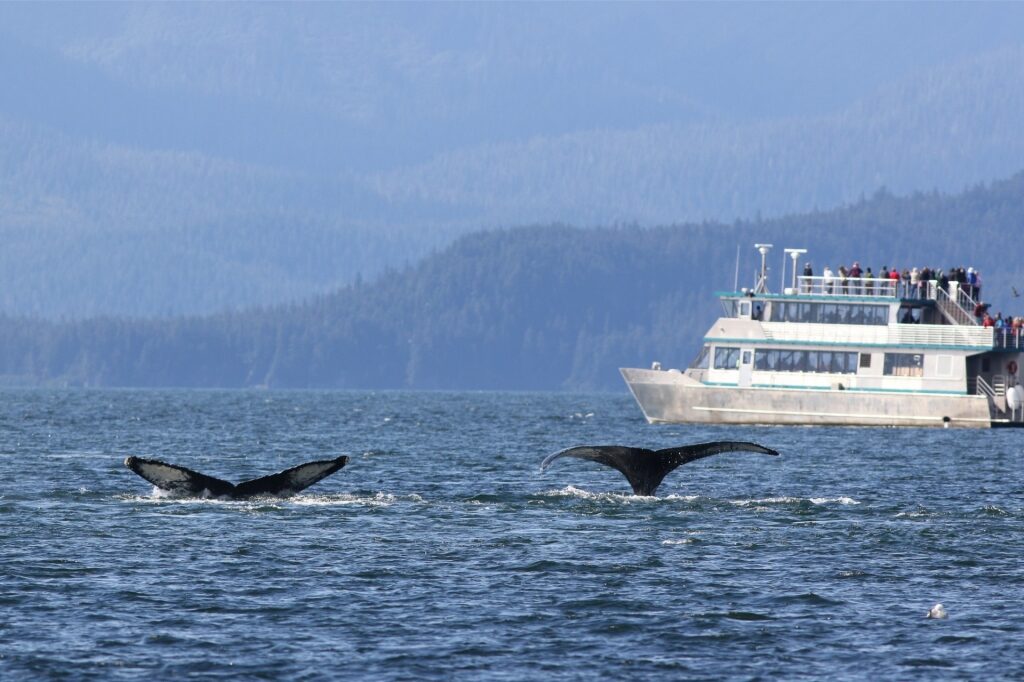
Humpback whales
If there is whale activity, the boat’s skipper will slow down the engine, and the guides will give commentary on what the whale is doing, for example, feeding, communicating with other whales, or “logging”, which is when it’s resting, floating motionless at the surface.
You may have the chance to help the crew with citizen science projects. Some boats will haul up a crab pot so you can examine and log its inhabitants; this is a way of monitoring which invasive species are populating Alaska’s seabed.
You can conduct your own research, too, with apps like Happy Whale, which involves photographing a whale’s tail fluke and uploading it. This is a way of tracking the migratory movements of individual whales.
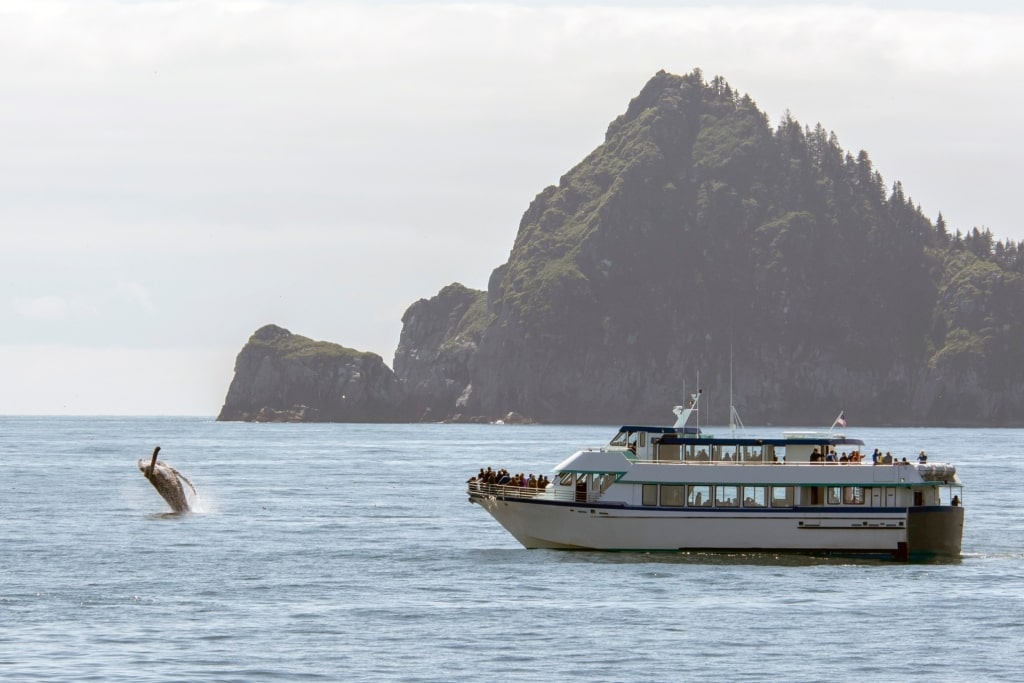
Kenai Fjords National Park
Whale-watching boats will most likely have a sheltered interior space as well as open decks. They will be equipped with a washroom and usually, a supply of refreshments. These do not usually include alcohol as whale watching is not regarded as a booze cruise.
There will also be marine mammal identification guides and sometimes a chart indicating which whales have been sighted that day or week.
If your whale-watching excursion includes lunch in the wilderness, there will, of course, be a much wider menu, and alcohol may be available at the lunch venue.
Best Places to Go Whale Watching in Alaska
Hubbard Glacier
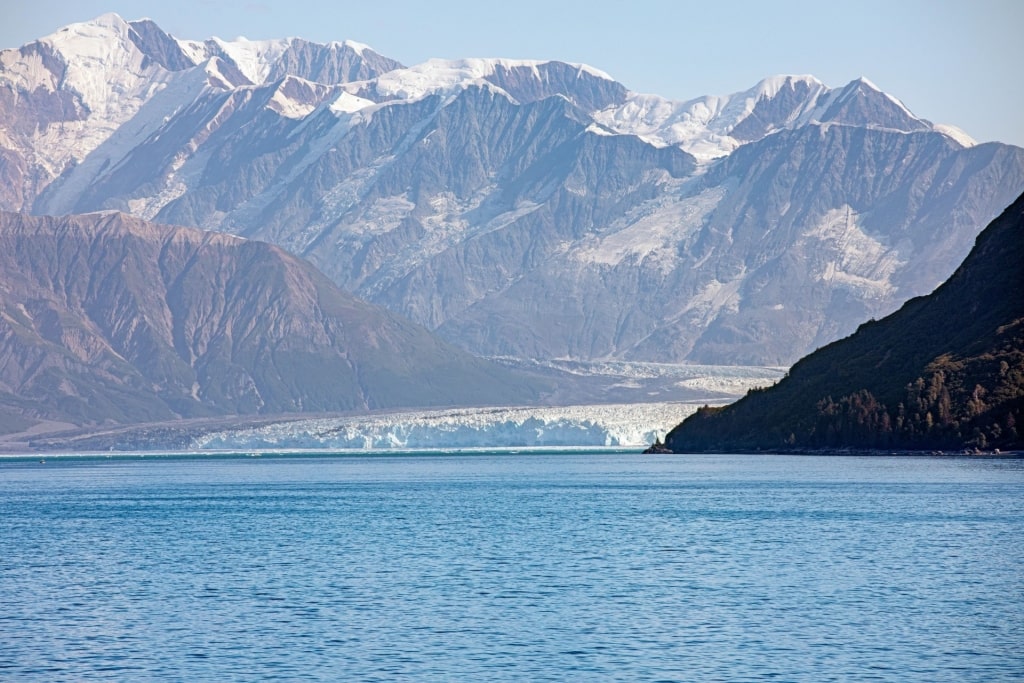
Hubbard Glacier
Hubbard Glacier is an enormous tidewater glacier, stretching 76 miles from Mount Logan in Canada to Yakutat Bay. This mountain of ice also happens to be one of North America’s most active glaciers.
With a width of around six miles at its face, Hubbard Glacier is one of the world’s widest tidewater glaciers, marked by frequent and thunderous calving events.
Humpbacks visit Yakutat Bay to gulp down krill, small shrimp-like crustaceans, while bald eagles command the skies above. Occasionally, minke and beluga whales also grace Yakutat Bay with their presence, making Hubbard Glacier a truly awesome spot for whale encounters.
Point Adolphus, Icy Strait Point
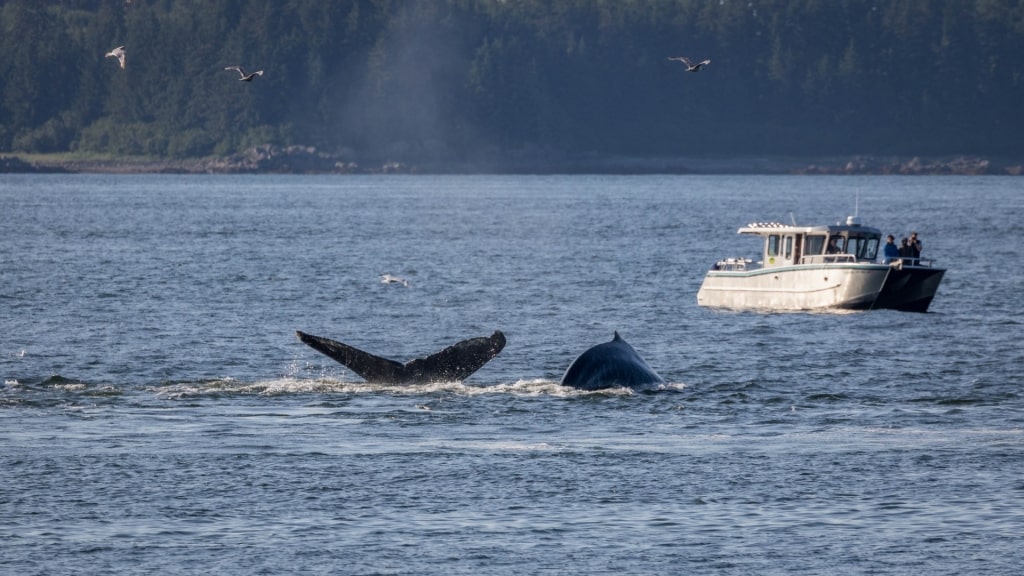
Point Adolphus, Icy Strait Point
Icy Strait Point is known as one of the best places to go whale watching in the world, and Point Adolphus in particular delivers a variety of opportunities to observe whales and dolphins in their natural habitat.
These coastal waters in Icy Strait Point are legendary for their gigantic humpback whales, which are something to behold. You’ll be able to observe their incredible breaching displays and listen to their haunting songs, especially between May and August.
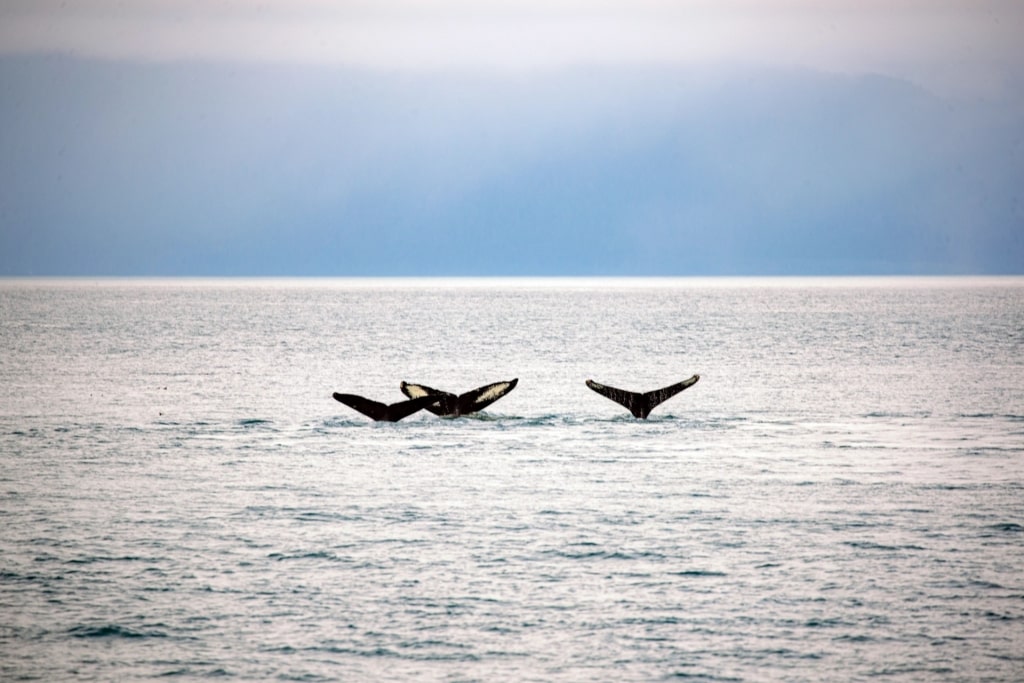
Point Adolphus, Icy Strait Point
The area’s distinctive blend of powerful tidal currents and underwater terrain fosters nutrient-rich food sources like krill for these baleen filter feeders to feast upon. An adult humpback can reach 40 to 50 feet in length and up to 40 tons in weight.
Other marine mammals drawn to Icy Strait include sea otters, Steller sea lions, Dall’s porpoises, and killer whales. To experience these animals in their wild grandeur, consider booking a whale-watching charter or signing up for a kayak tour.
Resurrection Bay & Kenai Fjords National Park, Near Seward
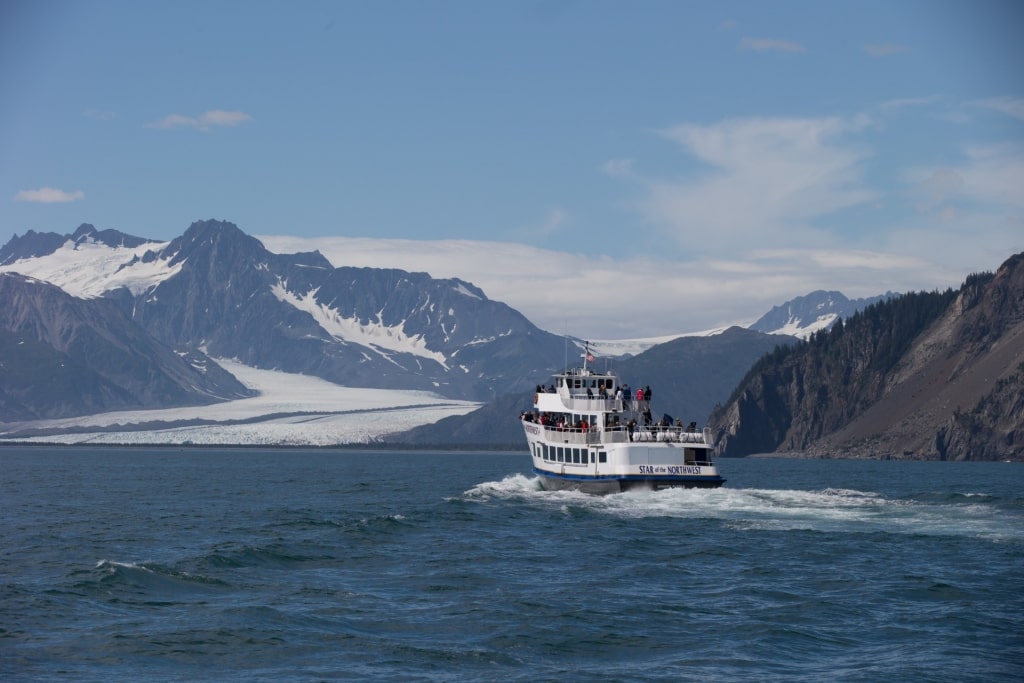
Kenai Fjords National Park
Resurrection Bay and Kenai Fjords National Park, near Seward, offer remarkable whale experiences. The region can boast year-round whale sightings, although the best time to see whales is usually March through October.
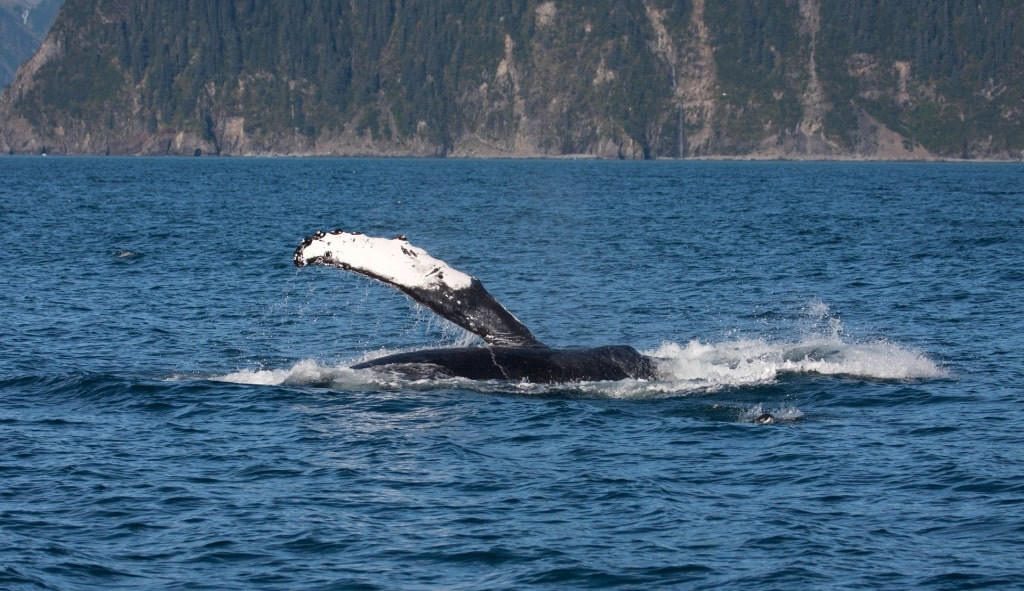
Resurrection Bay
The fjords in this area are rich in nutrients, which attract a wide variety of wildlife. During the spring, around March and April, gray whales make their way from Baja to the Arctic through the Gulf of Alaska.
In May, humpback whales arrive after migrating from Hawaii and Mexico, seeking krill-filled waters, where they feed until October.
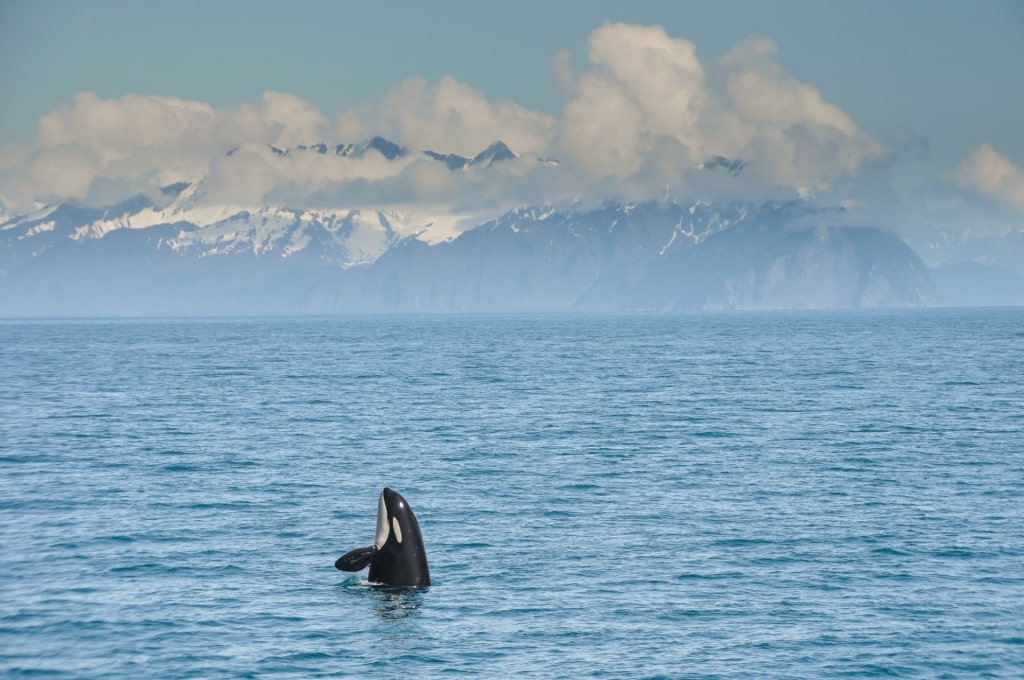
Resurrection Bay
In addition to spotting humpback whales and gray whales, you could see orcas in action as they hunt for their food.
You can also see lively Dall’s porpoises, named after the American naturalist William Dall, showcasing their acrobatic skills here, plus smaller harbor porpoises swimming along the coastline.
Misty Fjords, Near Ketchikan
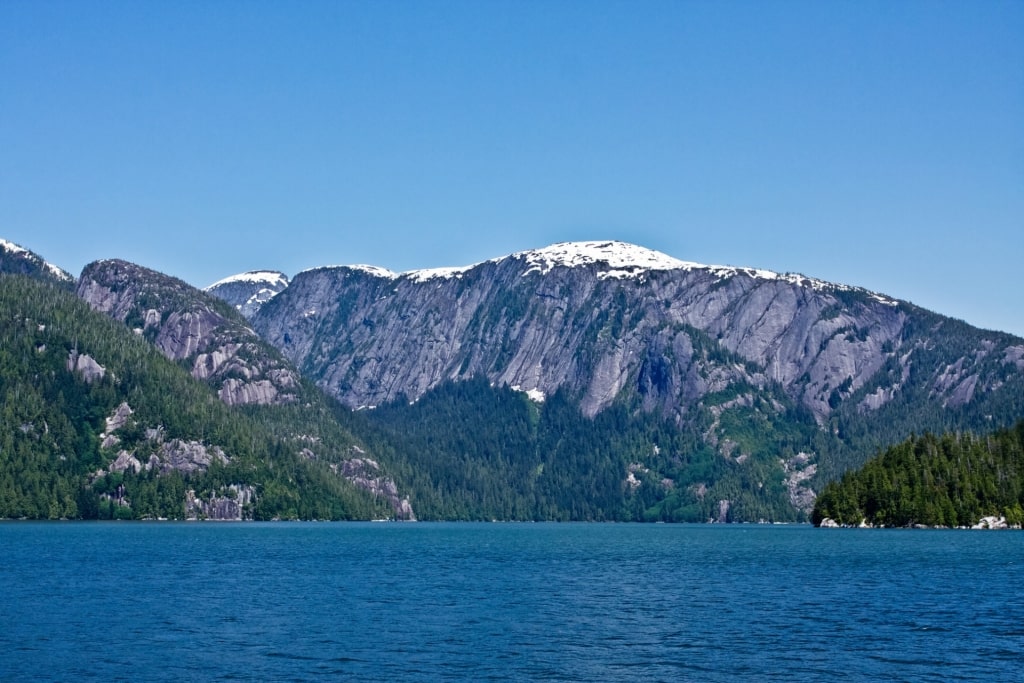
Misty Fjords
Misty Fjords, an expanse of water sculpted by beautiful Alaskan glaciers and surrounded by rugged terrain and steep cliffs, is defined by its boundless beauty.
To access the fjords, which lie northeast of Ketchikan, you’ll journey through Revillagigedo Channel, a water passage frequented by orcas and porpoises.
You can also experience the striking narrow fjords from a unique perspective by boarding a floatplane, providing you with a captivating bird’s-eye view. For a closer and more personal encounter with the region’s whales, you might want to consider booking a kayak excursion as well.
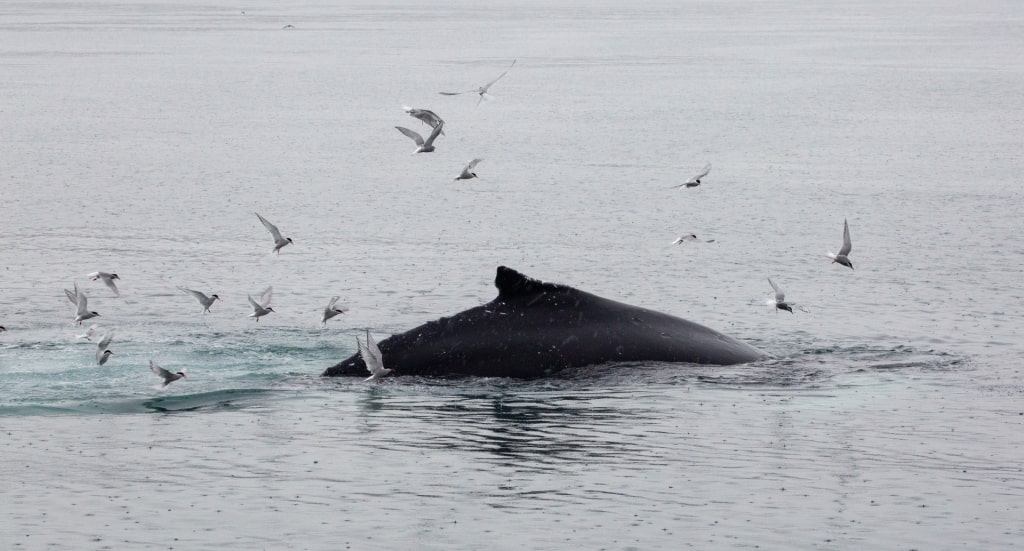
Humpback whale
Within the Misty Fjords National Monument Wilderness, the waters serve as a bountiful feeding habitat for humpback whales, Steller sea lions, and harbor seals.
Humpback whales, known for their arresting appearance, frequently breach the water’s surface, leaving an indelible impression on anyone who gets the chance to see them in the wild.
Turnagain Arm, Beluga Point, & Cook Inlet
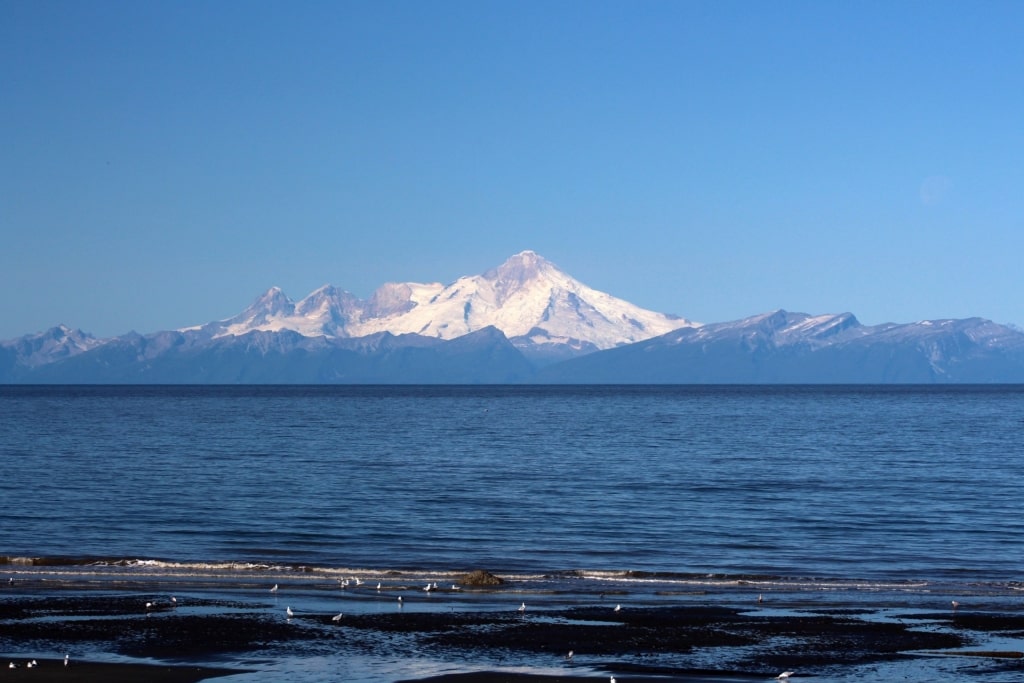
Cook Inlet
While engaging in whale-watching activities in Alaska, there are instances when you may need to invest some effort to catch sight of specific species, such as the Cook Inlet beluga whales.
The name “beluga” is derived from the Russian word for white; these ethereal white whales embody their name.
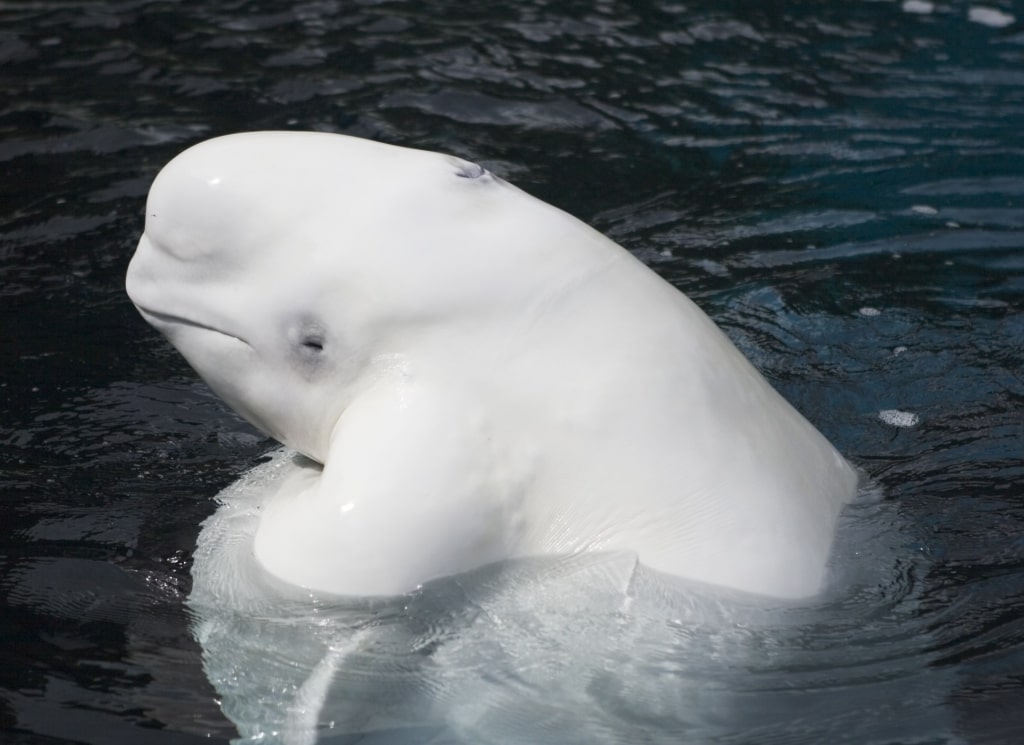
Beluga whale
The best time to visit Alaska to observe Cook Inlet belugas is from mid-August to October. These genetically unique, isolated, and endangered whales reside year-round in the muddy waters of the inlet.
The local belugas here navigate silty glacial rivers in search of food and can be spotted in the upper inlet river and bays near Anchorage during the spring to fall season.
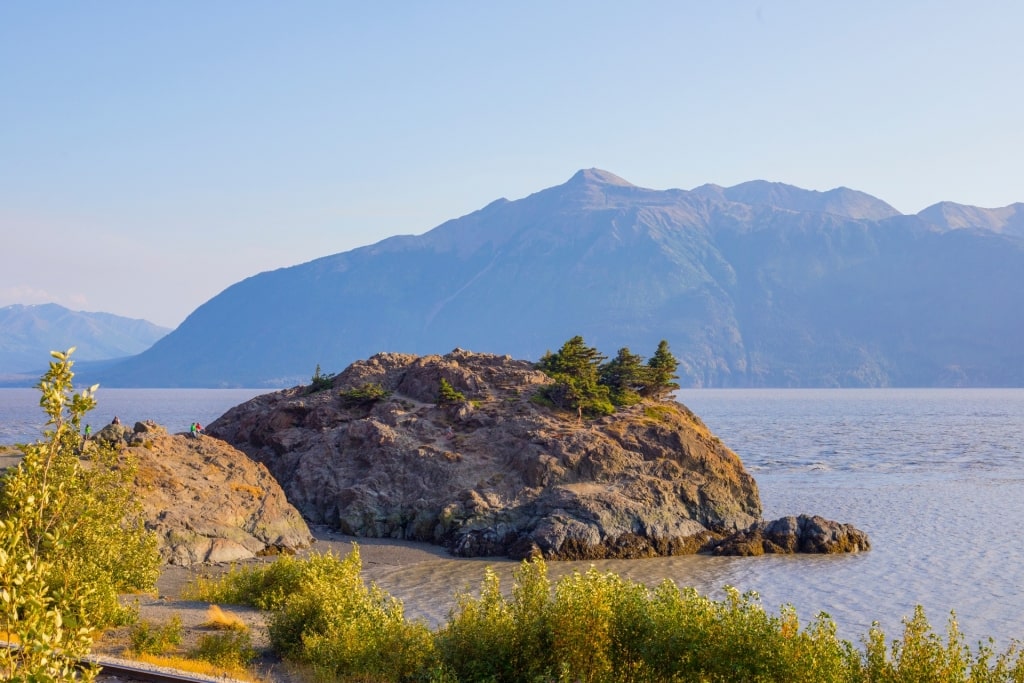
Beluga Point
Beluga Point, a rocky outpost along the Seward Highway, south of Anchorage, offers frequent sightings of these smallish white whales, especially during high tide. They don’t breach like other whales, so you’ll need keen eyes to spot them.
You can also observe belugas from scenic lookouts like Point Woronzof Park or Ship Creek Small Boat Launch, plus various turn-offs along the Seward Highway, which borders the Turnagain Arm coastline.
Haines, Skagway, & Davidson Glacier
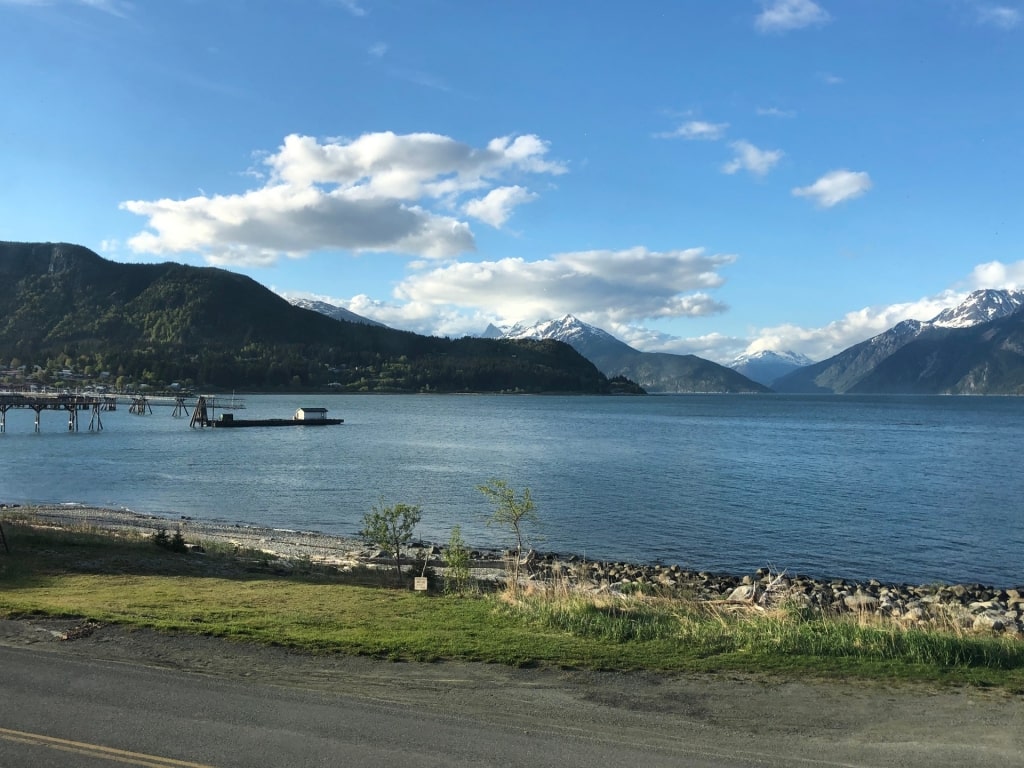
Haines
During the summer, humpbacks and orca traverse the Upper Lynn Canal seeking out different sources of food.
You can opt for a safari aboard smaller vessels from Haines or Skagway, located on Lynn Canal, North America’s deepest fjord. These safaris will transport you to the heart of the canal, offering you a closer view of the brilliant Davidson Glacier.
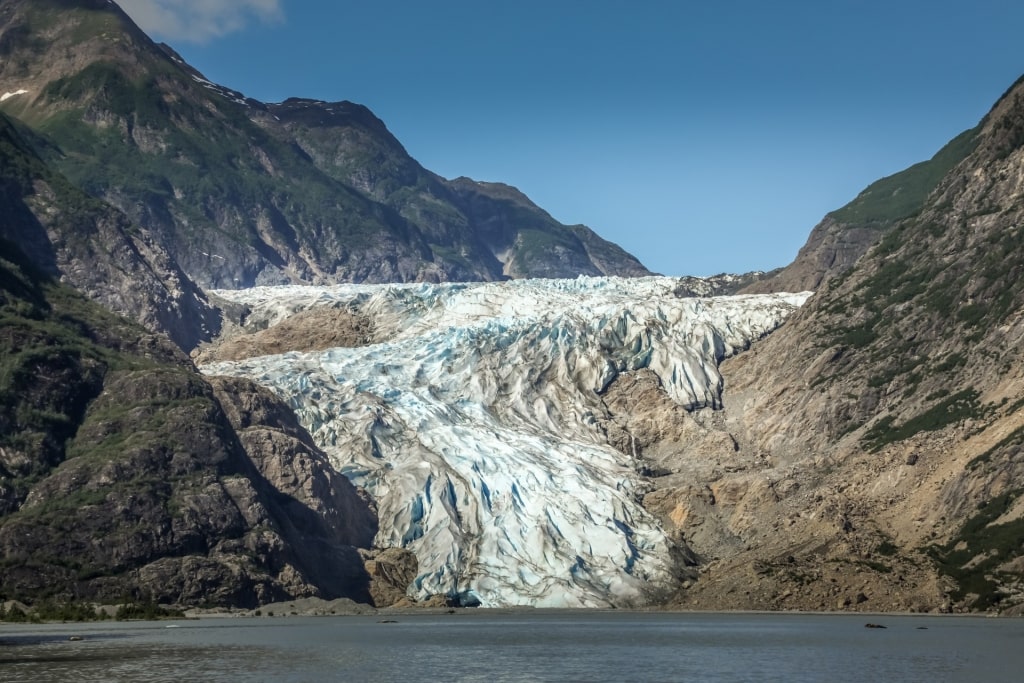
Davidson Glacier
While making your way toward the face of Davidson Glacier, be sure to remain attentive to the presence of humpback whales, sea lions, seals, and other local wildlife.
Endicott Arm & Dawes Glacier, Near Juneau
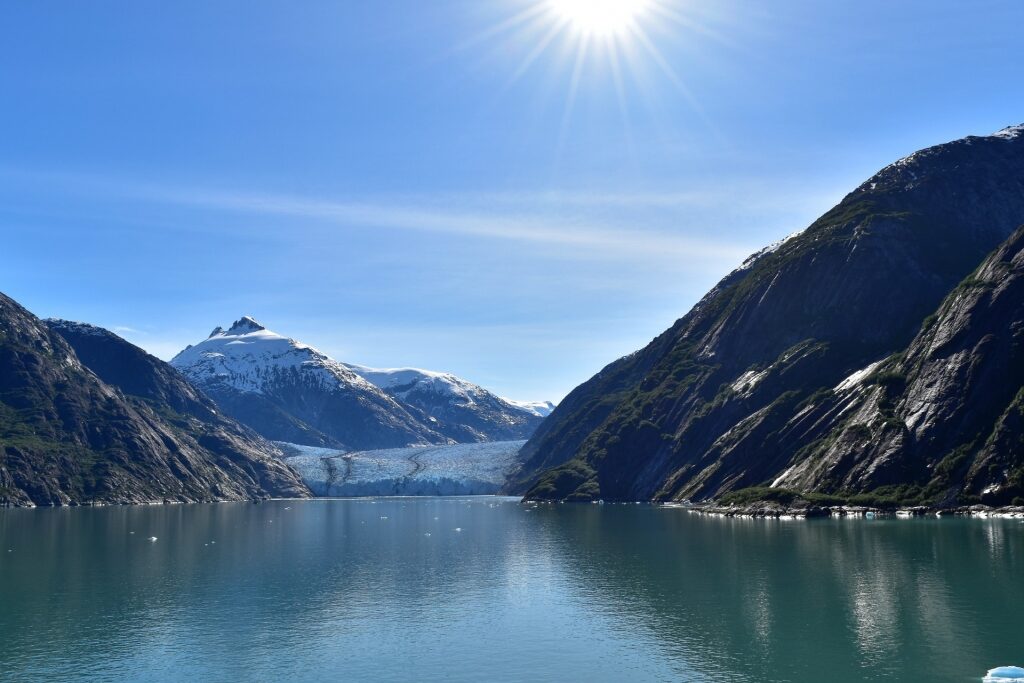
Endicott Arm
South of Juneau lies the entrance to Tracy Arm Fjords Terror Wilderness, near Holkham Bay. This wild region encompasses Tracy Arm and Endicott Arm, both accessible from Holkham Bay.
You’re sure to have a wonderful Alaska whale-watching trip through Endicott Arm, a deep fjord, as you watch humpback whales swimming and breaching, spot porpoises and orcas, and marvel at the tidewater Dawes Glacier in all its grandeur.
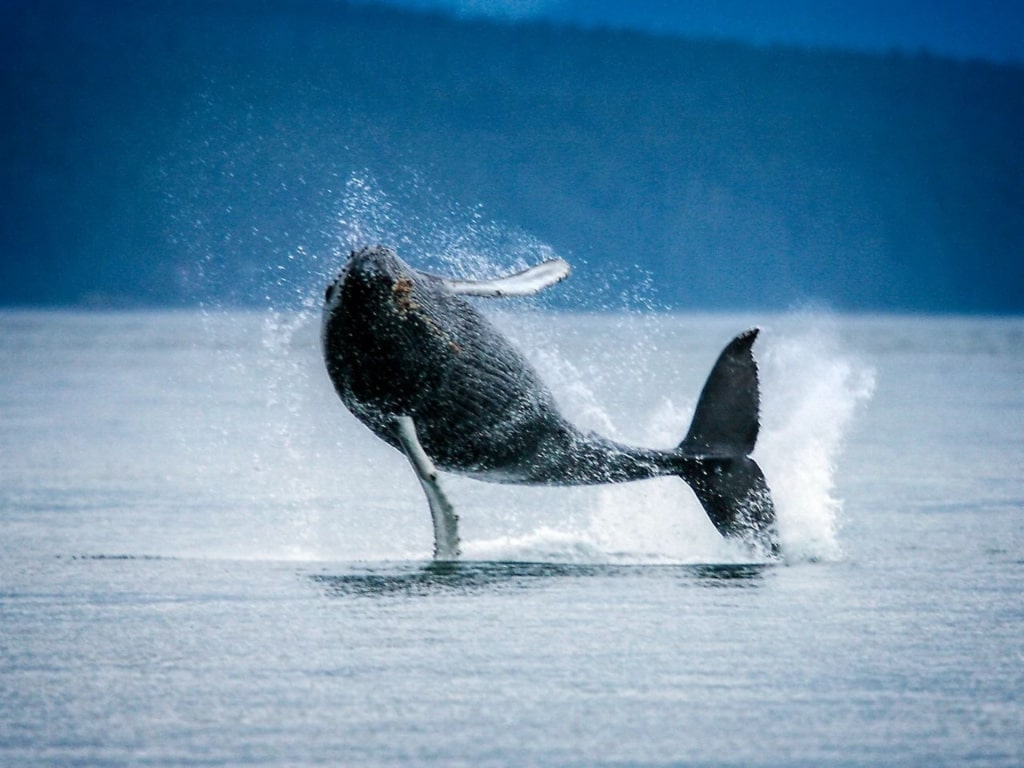
Humpback whale
Getting to witness the extraordinary sight of humpback whales releasing plumes of water from their blowholes against the majestic backdrop of calving glaciers and snow-capped Alaskan mountains in Endicott Arm is an experience you won’t soon forget.
Prince William Sound, Near Anchorage
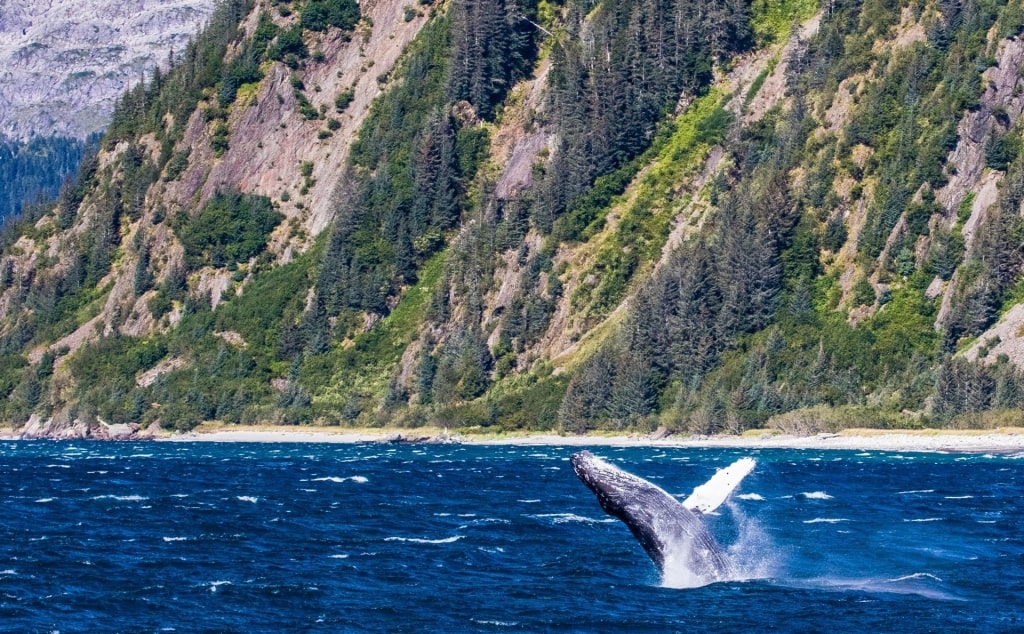
Prince William Sound
Prince William Sound, spanning thousands of miles of coastline, is a superb location for whale watching in Alaska. Some of the whale species you may meet here include fin, gray, humpback, and even minke whales. Of course, those wide-ranging, clever predators, the orcas, are present as well.
The sound, bordered by the jagged Chugach Mountains to the east and north, and the scenic Kenai Peninsula to the west, is home to a diverse marine wildlife population, which also includes sea otters, harbor seals, Dall porpoises, and Steller sea lions.
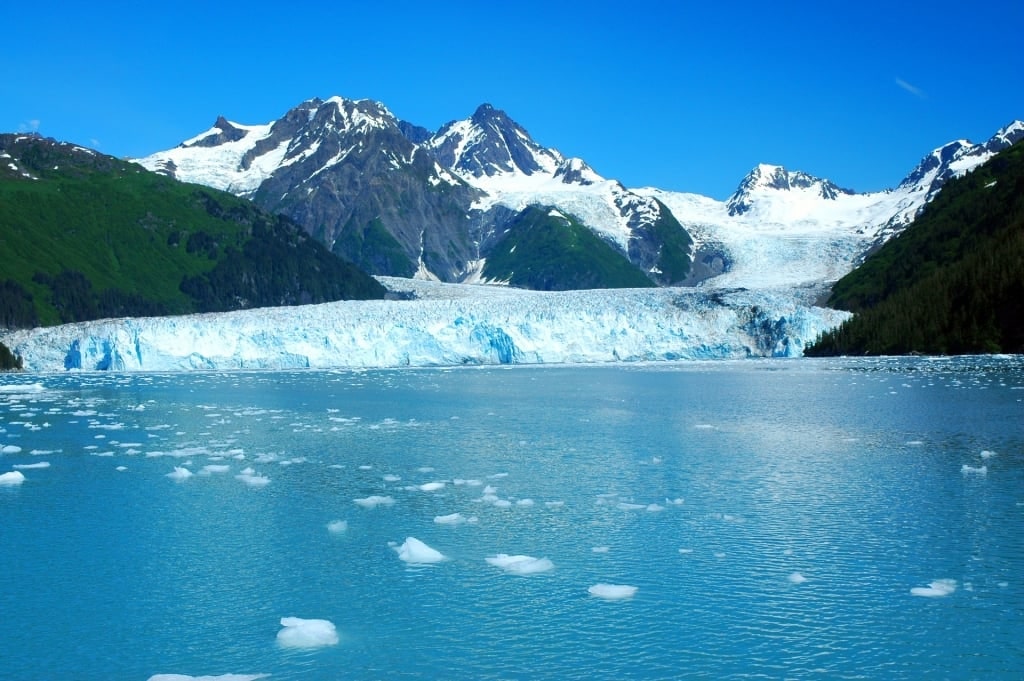
Prince William Sound
Located close to Anchorage, Prince William Sound offers a wide selection of whale-watching adventures to choose from, departing from Whittier, near Anchorage, and Alyeska.
During the spring and summer months, Prince William Sound becomes an exciting hub of whale-based activity, providing you with the possibility of witnessing these amazing creatures in action as they socialize, play, and search for food.
Kachemak Bay, Near Homer
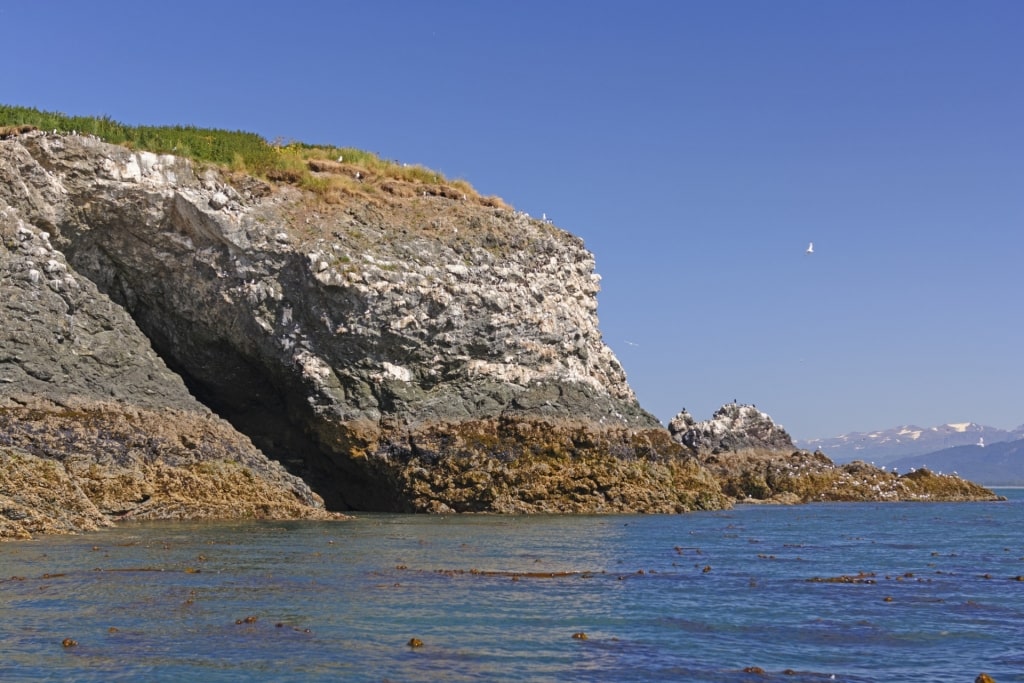
Kachemak Bay
Kachemak Bay is celebrated for its abundant and varied marine wildlife, drawing in avid whale-watching enthusiasts every single year.
The bay sees humpback whales, orcas, gray whales, and occasionally fin whales plow through its waters. Sea lions are also common here, and if you’re fortunate, you may catch a glimpse of beluga whales, too.
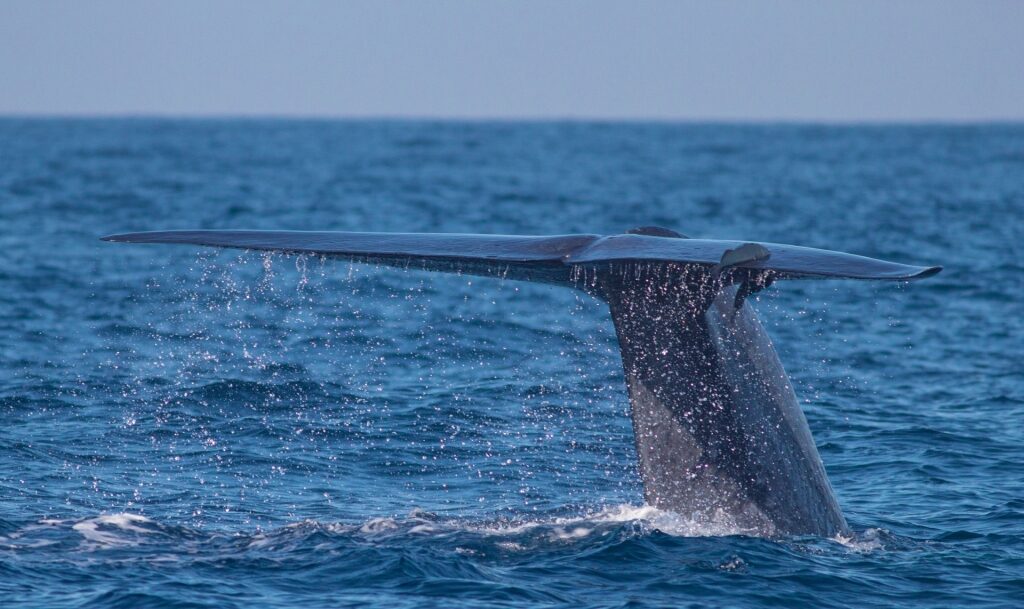
Blue whale
And if you’re extremely lucky, there’s a chance that you may get to spot enormous migratory blue whales, the largest creatures on the planet, cutting through the waves.
Whale-watching tours, which sail out of Homer, will teach you more about the region. Expert guides familiar with the local marine ecosystem will impart their knowledge, especially related to migrating species seeking food in Kachemak Bay, a part of Cook Inlet.
Stephens Passage & Frederick Sound, Near Juneau
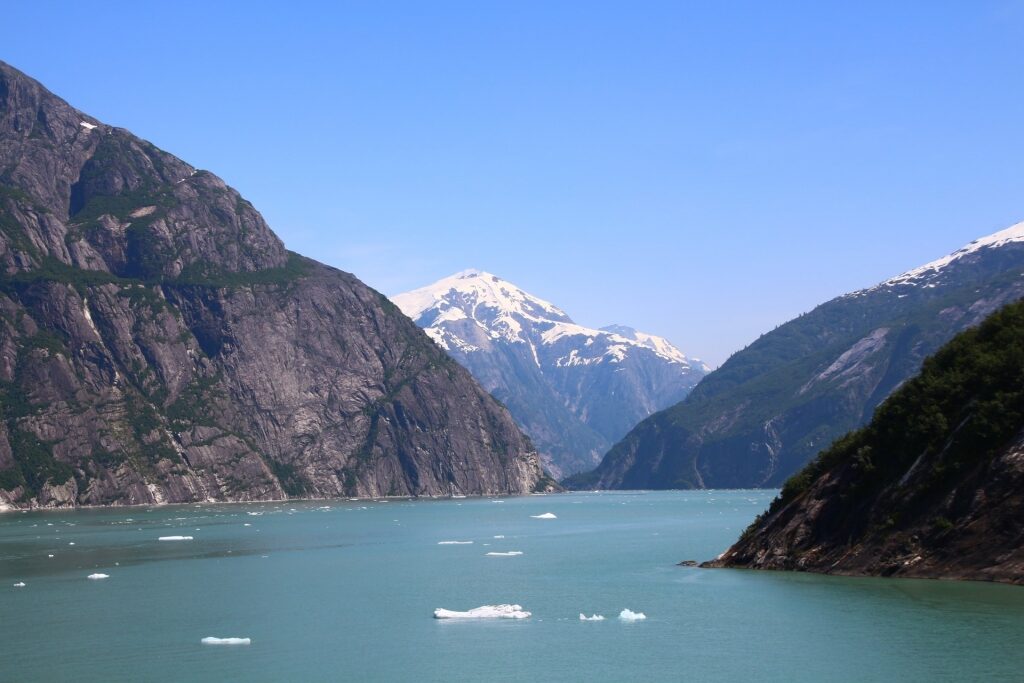
Stephens Passage
Stephens Passage, part of the Inside Passage, is packed with whale-based excitement. You could see the spectacle of over 100 humpback whales returning each year to feast on plentiful stocks of krill and herring, which is an incredible sight.
Stephens Passage and Frederick Sound, situated between Kupreanof Island and the mainland, are top-notch humpback whale-watching territories, best visited during the spring to early autumn.
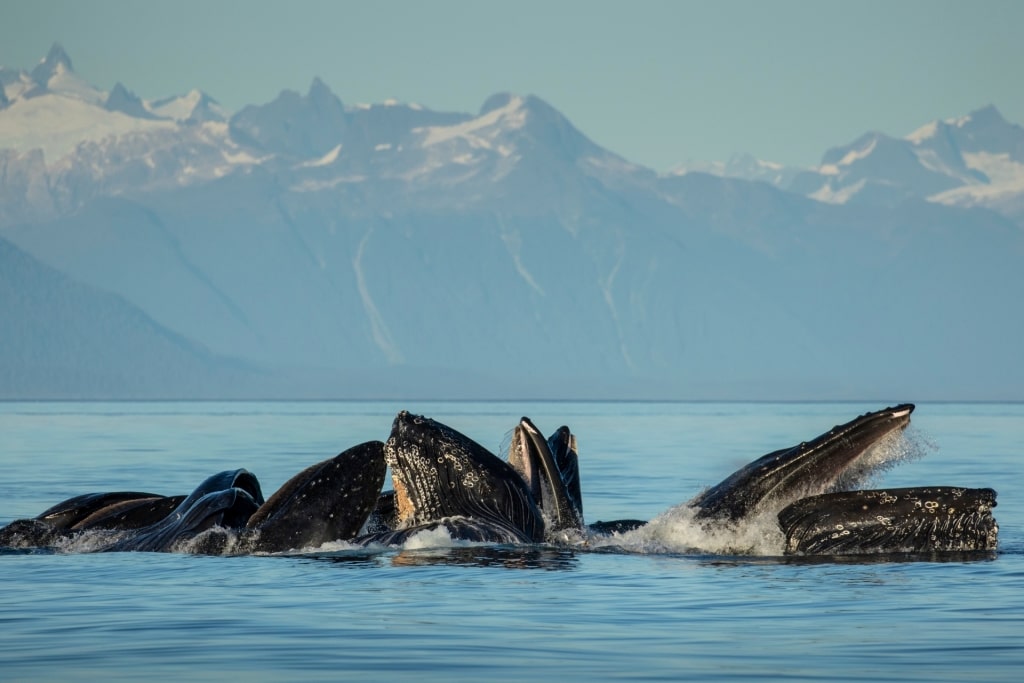
Humpback whale
Humpback whales spend approximately six months in Stephens Passage, feeding before returning to Hawaii for breeding and giving birth. Humpbacks are creatures of habit, and wildlife guides can often identify individual animals from their behavior and the marks on their tail flukes.
The region is also home to a vibrant community of Steller sea lions, while sightings of orcas and gray whales are also fairly common. If you want to schedule a whale-watching Alaskan adventure in Stephens Passage, consider smaller charters or catamaran cruises offered by operators based in Juneau.
Sitka Sound
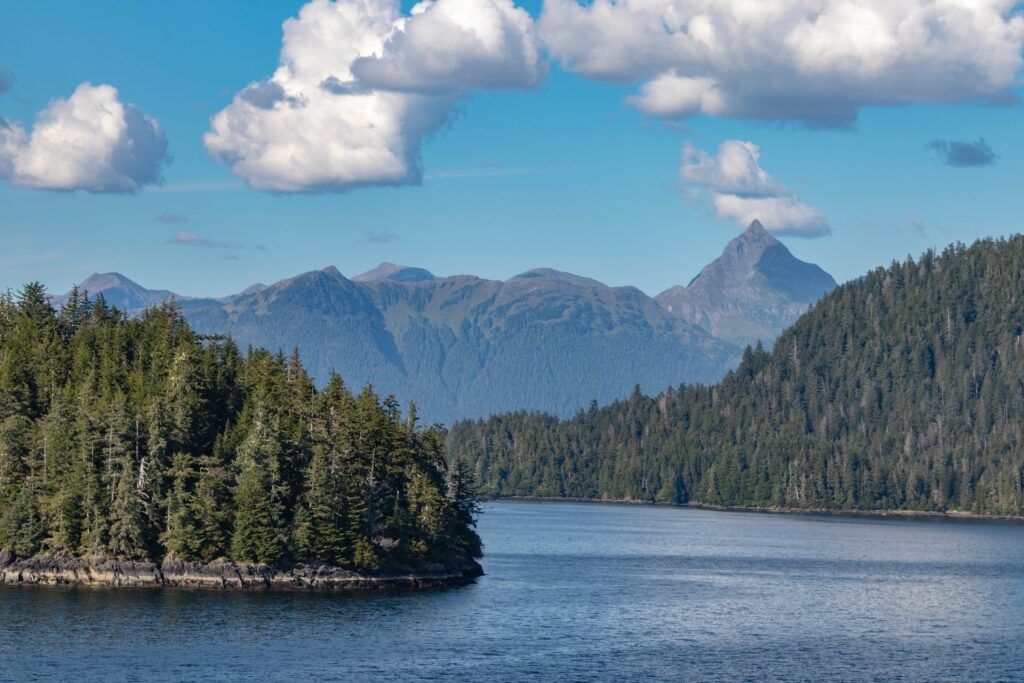
Sitka Sound
Sitka Sound and the town of Sitka, situated within the beautiful Alexander Archipelago in southeastern Alaska, rank high as reliable spots for whale watching.
This entrancing locale will present you with a variety of opportunities to witness the splendor of humpback whales, orcas, gray whales, and even, on occasion, minke whales.
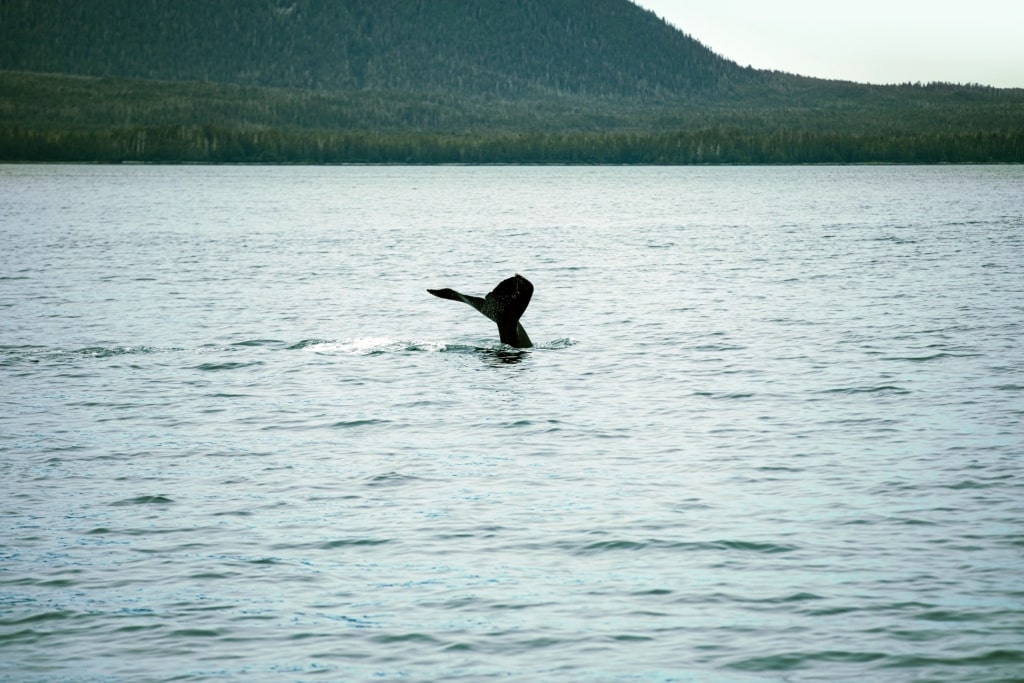
Humpback whale
Sitka’s proximity to the Pacific Ocean attracts diverse marine and avian species throughout the year. During fall in Alaska, it becomes a crucial resting place for humpback whales on their 6,000-mile round-trip migration to Hawaii.
Enhance your whale-watching time in Sitka by opting for a small vessel scenic excursion. These tours usually provide comfortable heated cabins, weather-resistant rain gear for unpredictable weather, quality binoculars, and expert guides to help ensure you have an exceptional marine mammal-spotting experience.
Tracy Arm Fjord, Near Juneau
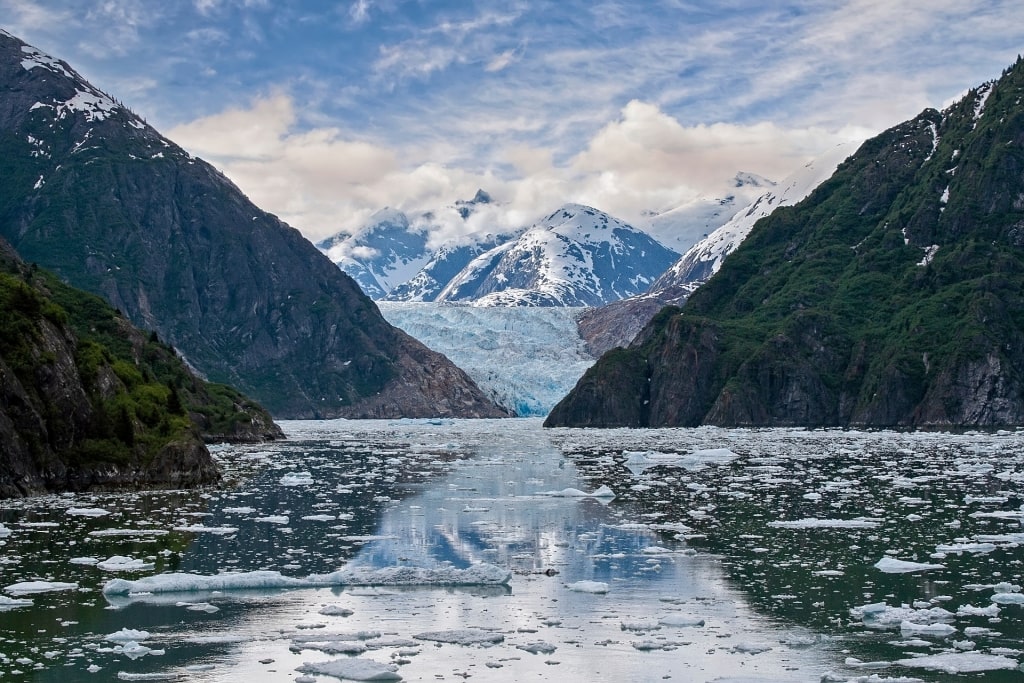
Tracy Arm Fjord
Tracy Arm lies within the Tracy Arm-Fjords Terror Wilderness and offers fantastic whale-watching opportunities in Alaska.
Orcas and humpback whales are frequently spotted in Tracy Arm thanks to the abundance of food here, particularly during the summer in Alaska.
Humpback whales migrate to Tracy Arm to dine on small fish and plankton, joining other marine mammals, including killer whales, porpoises, seals, and sea lions.
Whale Watching in Alaska FAQs
What is the best month for whale watching in Alaska?
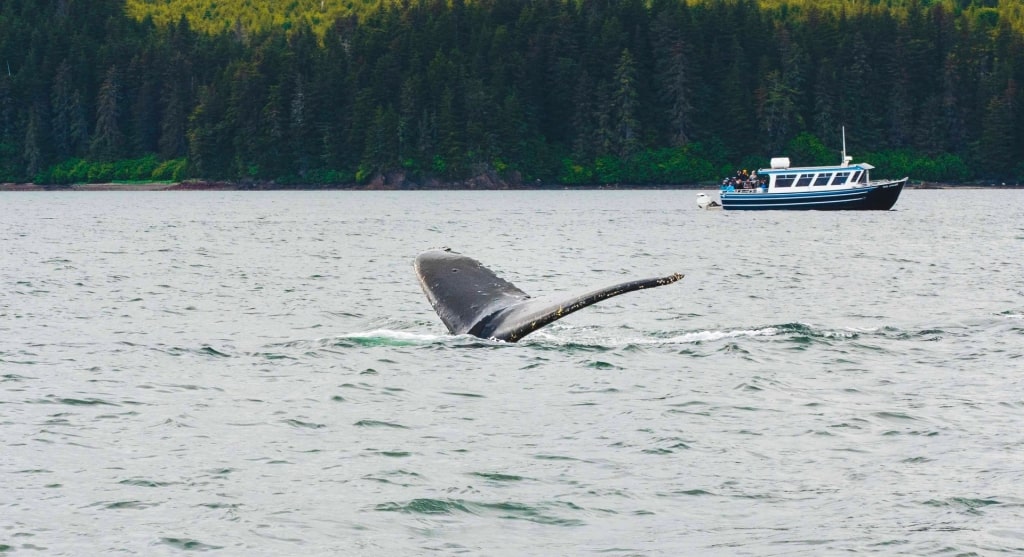
Whale watching in Alaska
Whales can often be spotted during Alaska’s cruise season, which runs from May through September. After spending the winter in the warmer southern waters of the Pacific Ocean, by spring, most whales have made their way up the coastline of North America and have arrived in Alaska, where they’ll feed and teach their offspring how to hunt until the early fall.
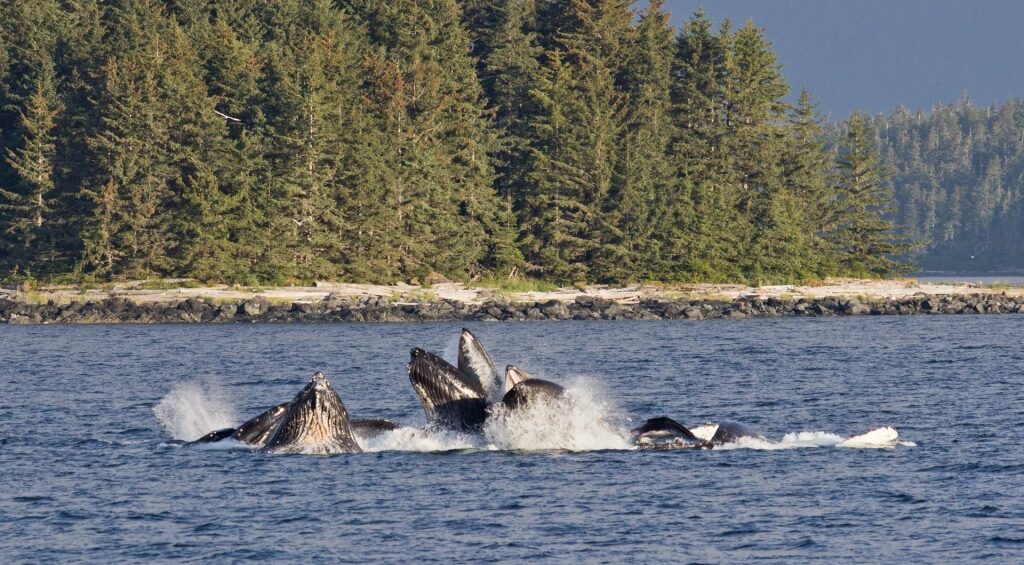
Humpback whales
However, there are certain months when you’re more likely to see certain species of whales than others. Humpback whales tend to be more visible in the months of June and July.
As for gray whales, they are more likely to be spotted earlier in the season, while blue whales are more prevalent during the last half of the summer in Alaska.
How likely is it to see whales on an Alaskan cruise?
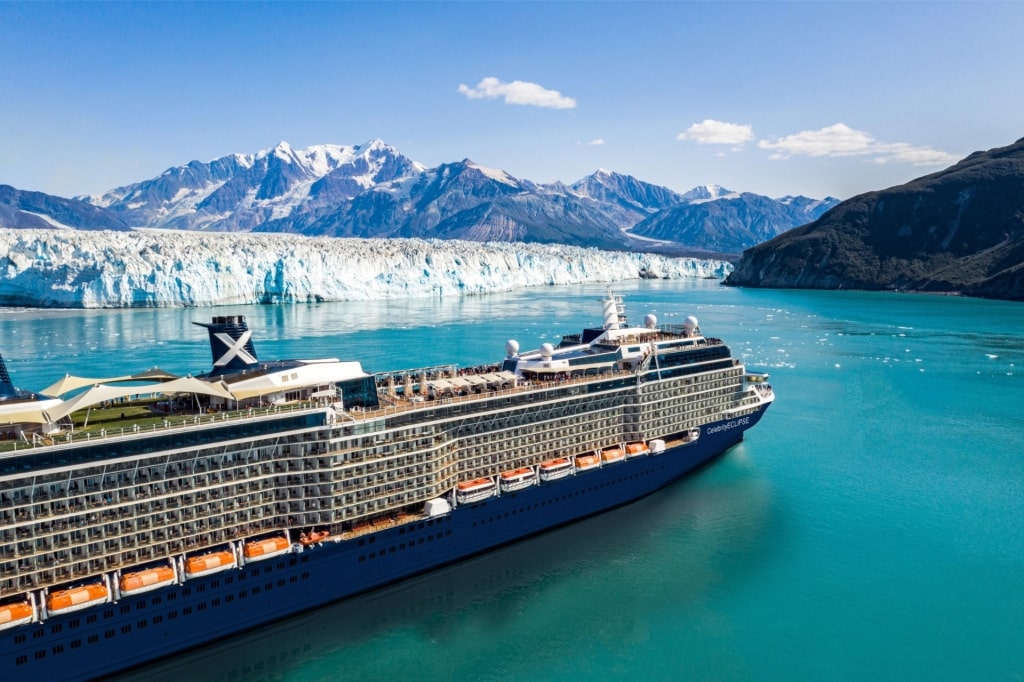
Hubbard Glacier
It’s extremely likely that you’ll see whales on your Alaska cruise. But these are wild animals, so nothing is guaranteed. You would, though, be very unlucky to spend a whole week here without a sighting, either from your ship, the shore, or on a whale watching excursion.
You will certainly maximize your chances on an organized excursion with an expert guide. You could see whales on a kayaking trip, too.
If spotting whales is the biggest reason you’re coming to Alaska, time your trip for June, July, or August, when humpbacks will definitely be present.
How long does a whale watching tour in Alaska typically last?
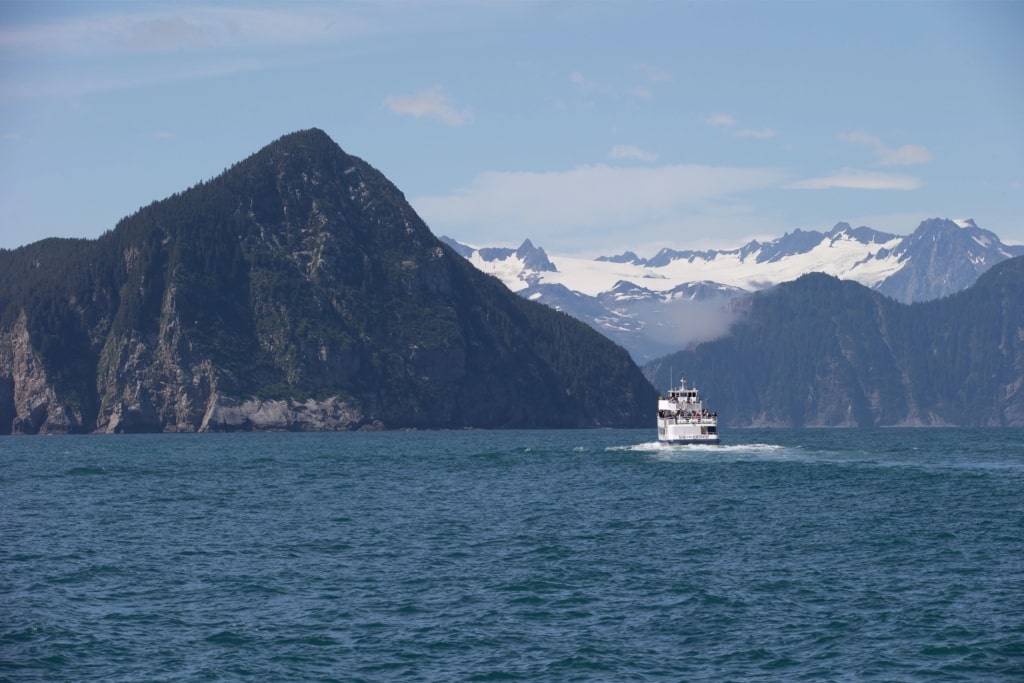
Kenai Fjords National Park
Most whale watching tours are three or four hours long. You can book longer tours, which might involve other activities such as a salmon cookout at lunchtime or a visit to a glacier. Some tours stop for a hike through the forest and along remote shorelines, where you could spot otters, sea lions, eagles, and even bears.
What are the best conditions for spotting whales?
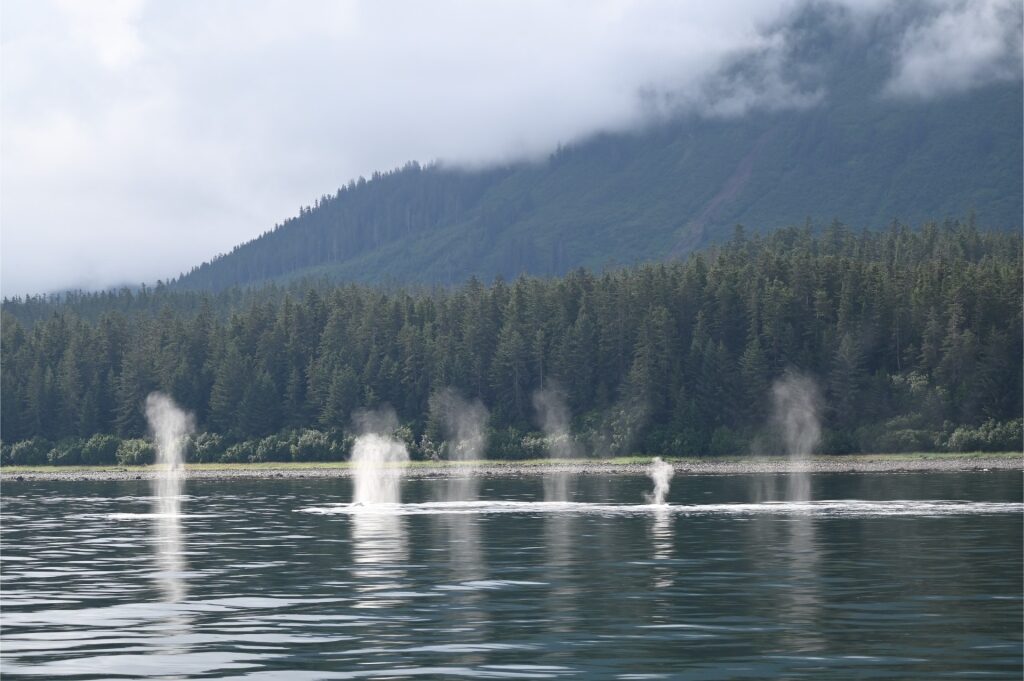
Point Adolphus
In an ideal world, you’d have a flat sea and sunlight to spot whales. The first telltale sign of a whale is its blow, which is easy to spot when the sea is calm. Different whale species have a different-shaped blow, so you can hone your skills.
A humpback’s blow is about 10 feet tall and bushy in shape, while a blue whale’s tall, thin blow extends 30 feet into the air.
In calm conditions, you can also see what’s called the flukeprint, a smooth circle of water that means a whale has just dived down deep. But whales have to breathe and they have to feed, so they will be active in all kinds of weather.
Do I need to book whale watching tours in Alaska in advance?
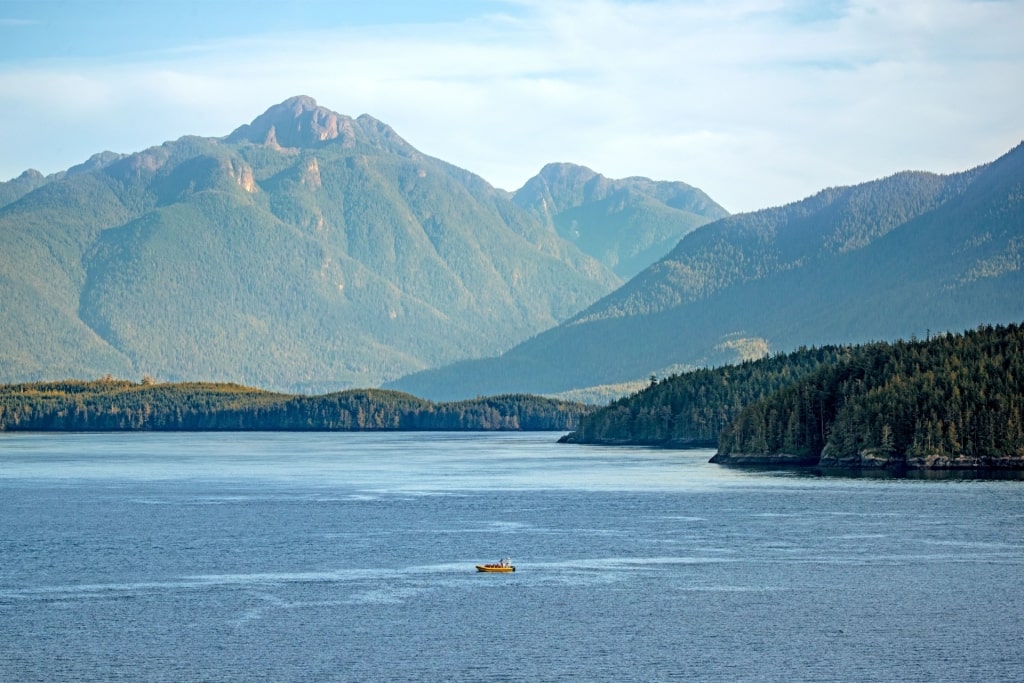
Alaska
Yes, it’s a good idea to book your whale watching tour in advance. Whale watching is one of the most popular things to do in Alaska, and boats often have limited capacity.
Bear in mind that whale-watching excursions take place in almost any type of weather, so unless it’s actually unsafe to go out, the tour will go ahead.
Where is the best whale watching in Alaska?
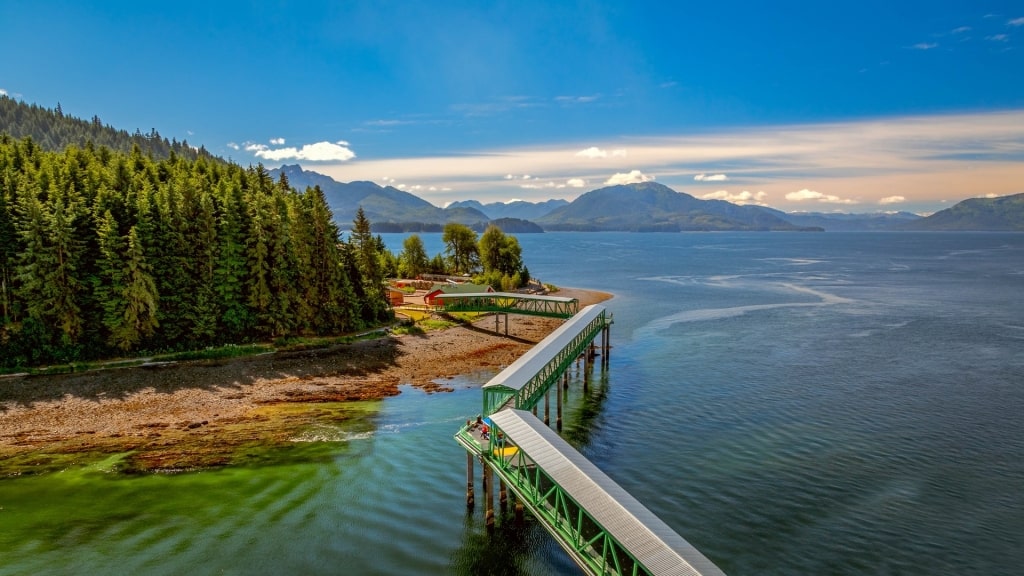
Icy Strait Point
The best way to ensure you’ll see whale wildlife in action is to visit places that are near whale migration paths and feeding zones in the region.
The best whale-watching ports of call are typically Juneau, Icy Strait Point, Ketchikan, and Sitka.
Can you see whales from the cruise ship in Alaska?
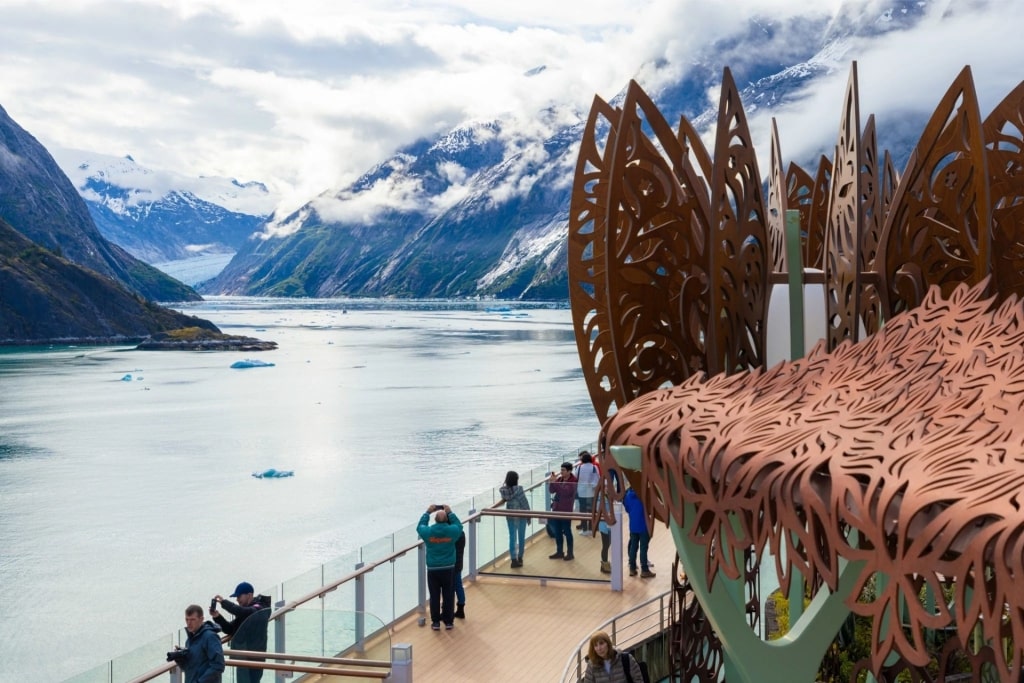
Inside Passage
Of course! One of the perks of an Alaska whale watching cruise is the opportunity to see wildlife from the comfort of your ship.
To increase your chances of successful whale watching while on board, hang out on one of the cruise ship’s many open-air decks. The best place to stand is as high up as you can, with as wide a sphere of vision as possible.
If you prefer to be inside, pick public areas with large windows instead. Keep your ears open for announcements on the ship’s loudspeakers, as they’ll often alert passengers if a whale has been spotted and will even let you know what side of the ship you’ll be able to see it.
Although the whale could, of course, dive or swim from one side of the ship to another. This is why multiple sets of eyes are better than one.
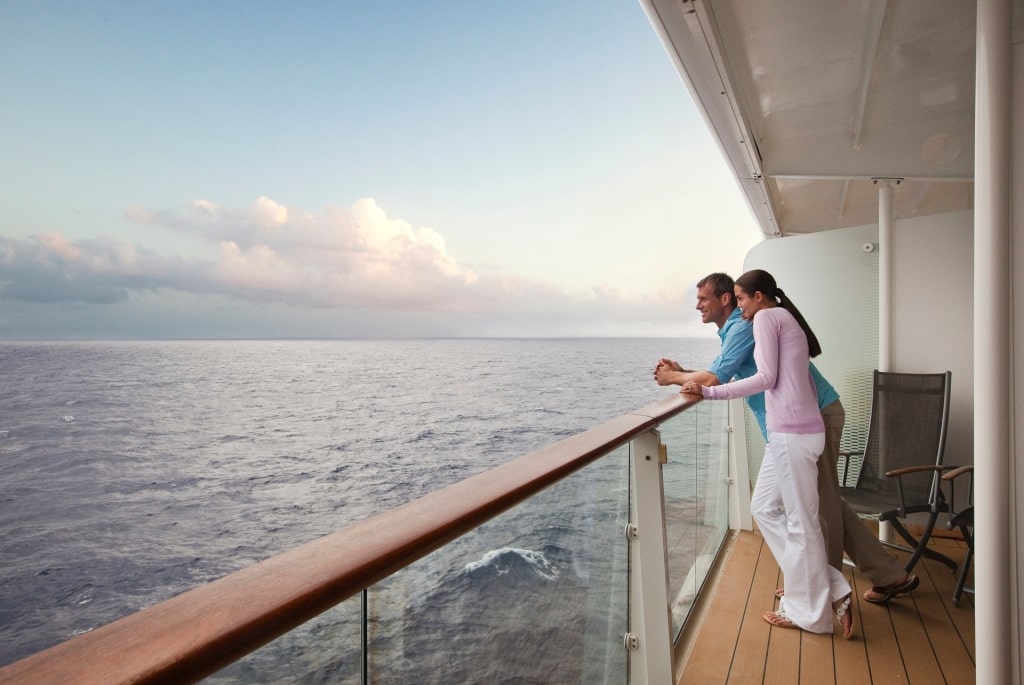
Veranda Stateroom, Celebrity Cruises
Another way to increase your odds of seeing whales from the ship is to book a veranda stateroom or suite. Having your own private veranda will allow you to step out or lounge by the water, maximizing the number of opportunities you’ll have to look out at the ocean.
Sit on your balcony with a hot cup of coffee or fine wine and scan the horizon for the telltale sign of a whale: a plume of warm, moist air shooting up a whale’s blowhole.
What should I bring on an excursion to see whales in Alaska?
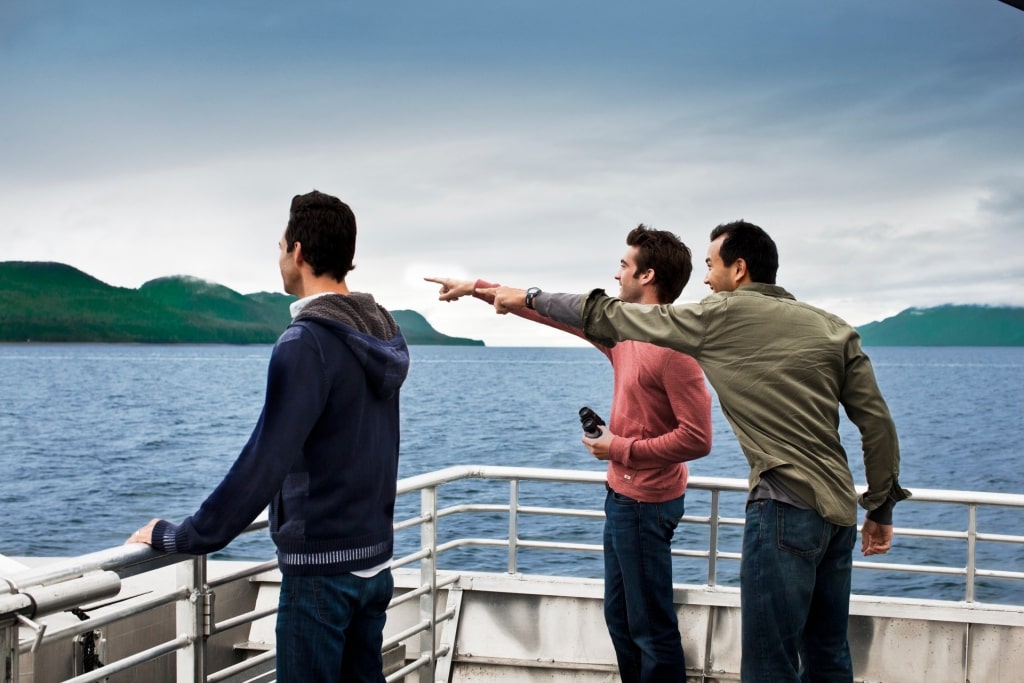
Whale watching in Alaska
Bring a pair of binoculars and a cleaning cloth for the lens, which is likely to get salty when you’re out on a small boat.
Polarizing sunglasses will protect your eyes and give you a clearer view of the water. A camera with a zoom lens is a good idea, although capturing that iconic moment of a humpback breaching will take luck, timing, and skill.
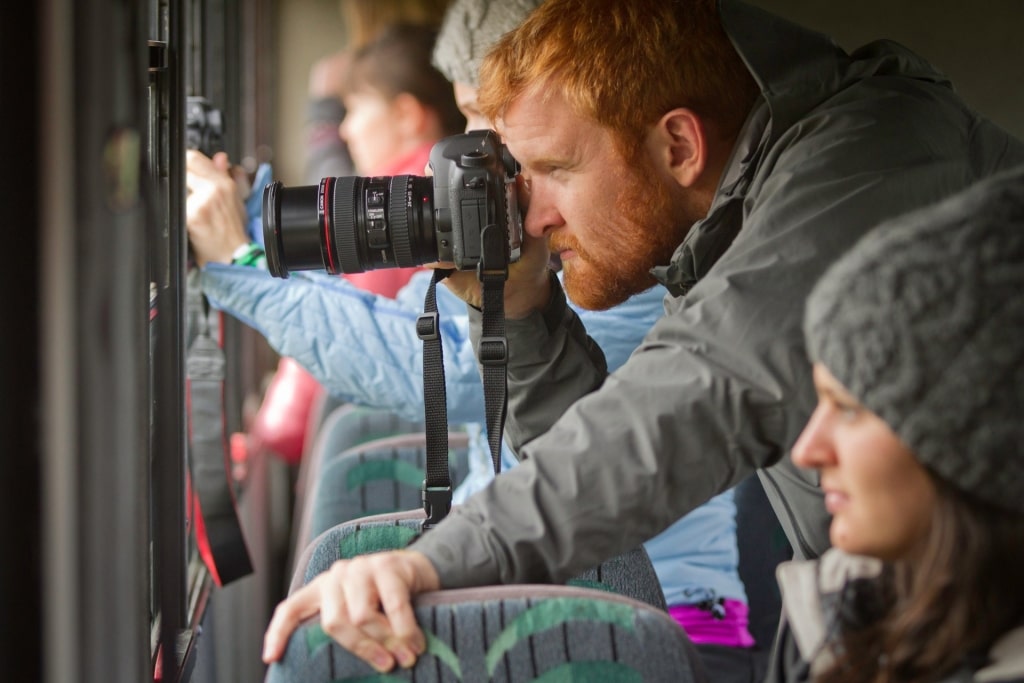
Camera
When planning what to pack for an Alaska cruise, be sure to bring a sturdy strap for your camera. If you’re going on a whale watching excursion while in port, consider bringing a dry bag to protect your camera and valuables from water or ocean spray.
Whale watching trips go out in all weather apart from the very roughest seas, so pack a waterproof jacket. If it looks like a cool, gray day, bring along gloves and a hat, too. Layers are always the best option in Alaska, when the weather can change in an instant.
Also, if you’re prone to seasickness, dose up before you leave; the last thing you want on a thrilling whale watching trip is to feel queasy.
What are some whale-watching excursions I can take during an Alaska cruise?
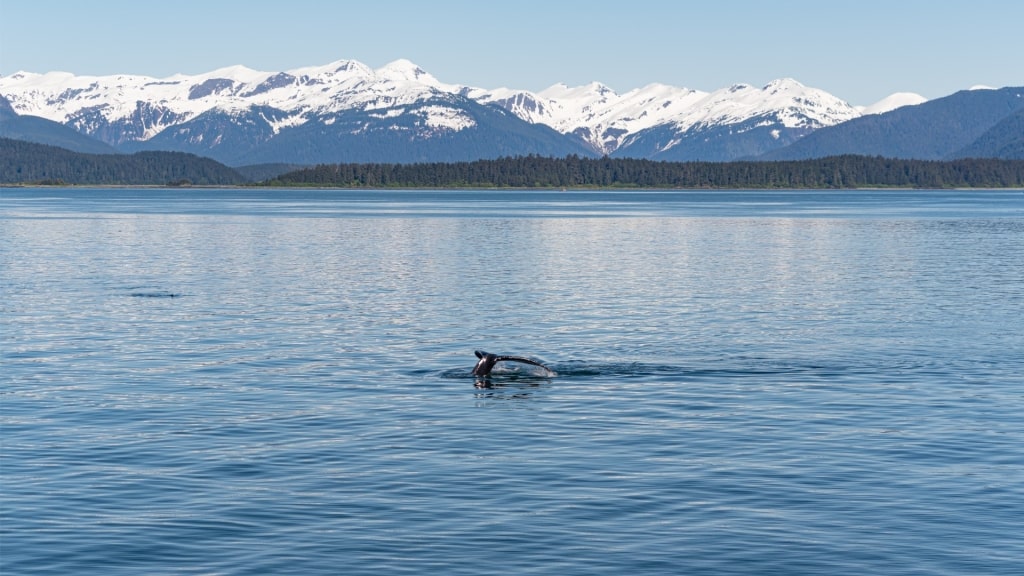
Auke Bay
The best way to make sure you spot whales on your Alaska cruise route is to take part in a whale-watching shore excursion. There are several unforgettable excursions at many of our Alaskan ports of call.
Here are some popular excursion ideas for those who want to maximize their chances of seeing whales in the wild, and possibly even more than one kind of species.
Whale Watching Excursions in Icy Strait Point
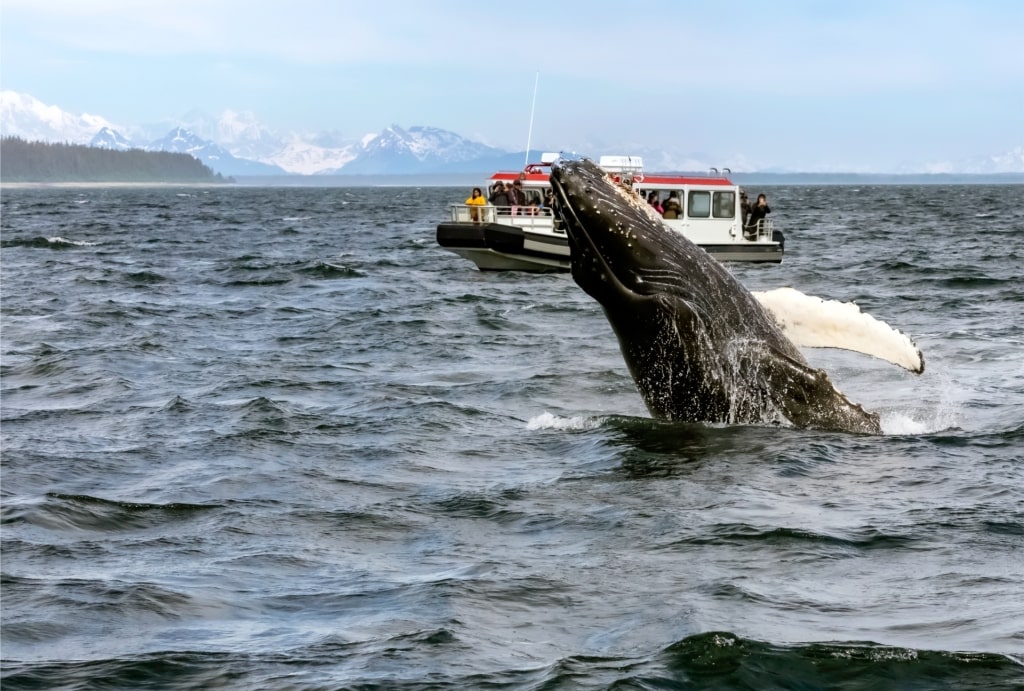
Icy Strait Point
While in Icy Strait Point, you’ll have the chance to take a shore excursion to Point Adolphus, an active feeding ground and one of the best humpback whale viewing areas in Alaska. Spotting wildlife at Point Adolphus is all but guaranteed, since a large number of whales gather here during the summer to feast on the nutrient-rich water found in the area.
During your high-speed sightseeing cruise, you’ll be accompanied by a naturalist who will relay fun facts about the scenery and the animals that you’ll encounter during your cruise.
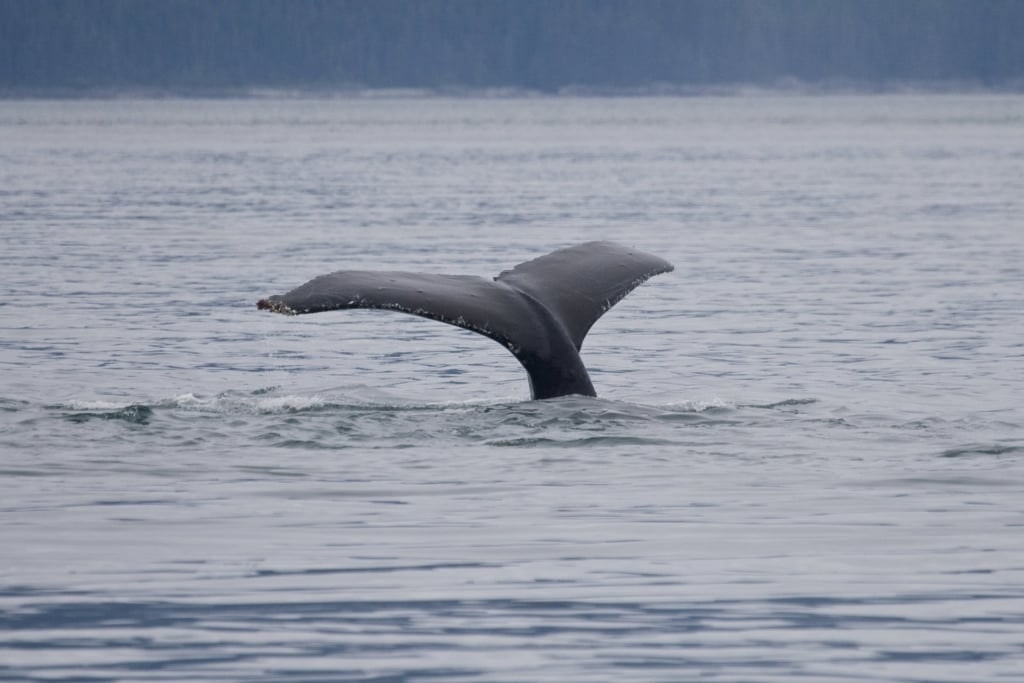
Humpback whale
Icy Strait Point provides a wonderful opportunity to see Freddy, a local favorite and one of Alaska’s most famous humpback whales. Unlike other whales that migrate south in the winter, Freddy stays in the bay by Icy Strait Point year-round.
He’s also known as the only solo bubble-net feeder in the area. Bubble-net feeding is typically done in groups, when numerous whales blow bubbles around a school of fish to trap and later feast on them. Freddy is considered unique for accomplishing this activity on his own with a special spiral bubble pattern.
Whale Watching Excursions in Juneau
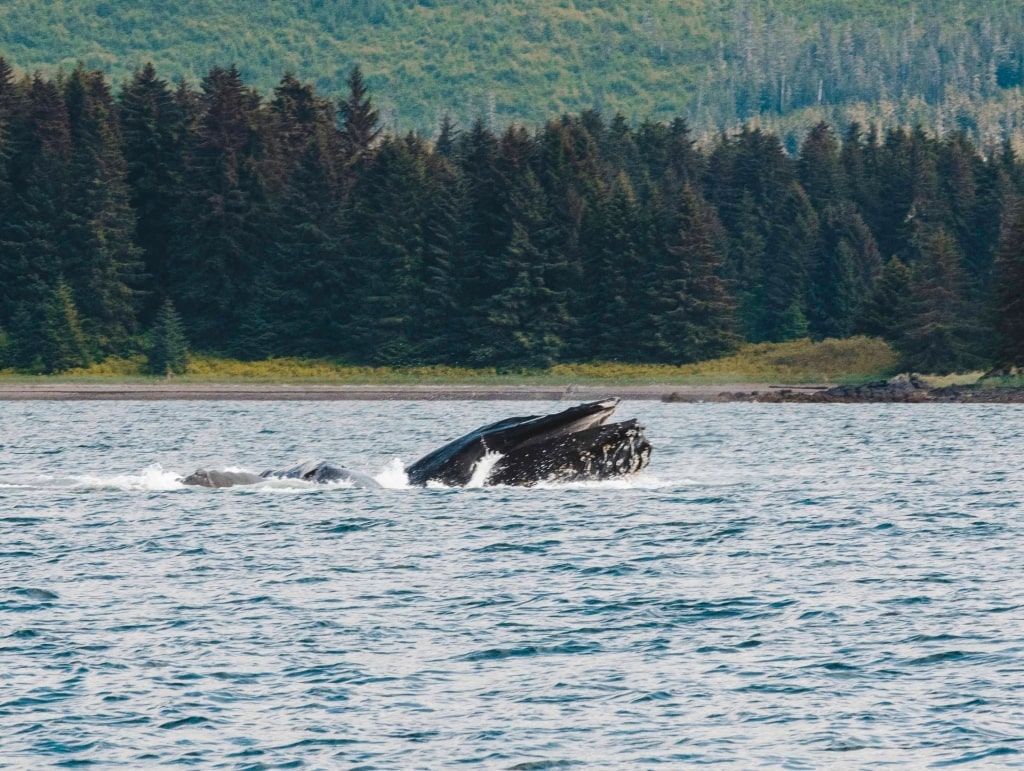
Juneau
There’s a wide range of iconic Juneau experiences that include plenty of whale watching. Board a catamaran and cruise around Stephen’s Passage, where you’ll have the chance to see humpback whales and get glimpses of the vast Mendenhall Glacier, which spans an impressive thirteen miles. Finish off your outing with a stop at Orca Point Lodge, where you’ll enjoy a traditional salmon bake breakfast.
If you’re looking to spot a more diverse number of species, take an excursion along Stephen’s Passage and Auke Bay for whale watching and the chance to see seals and soaring bald eagles, too.
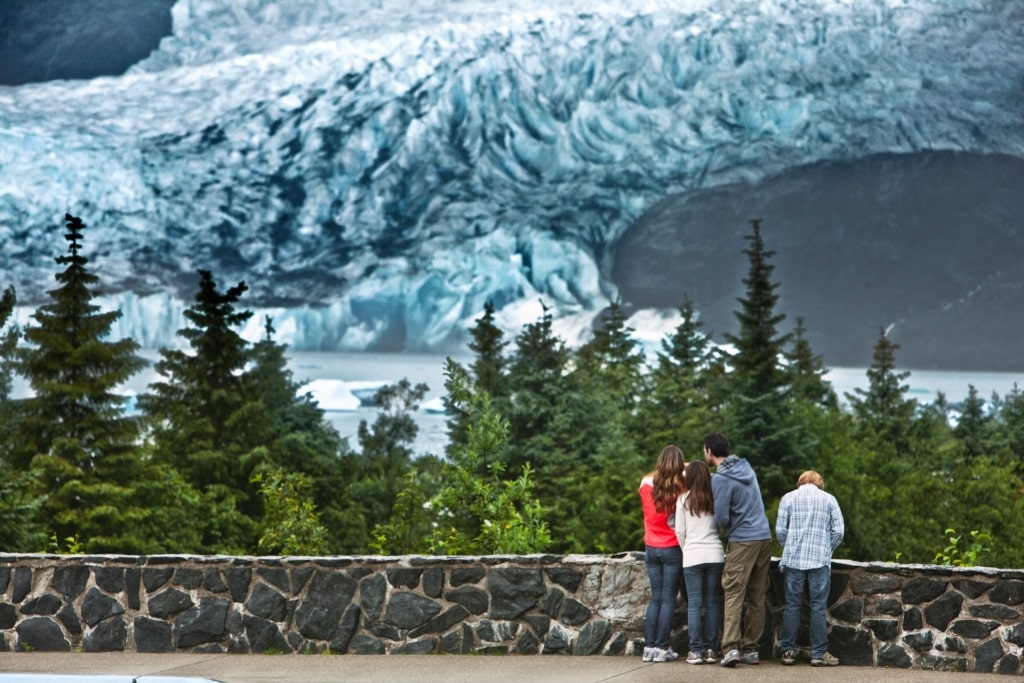
Mendenhall Glacier
Score some epic photos for your social media accounts during a hike around the rainforest surrounding Mendenhall Glacier, where you’ll see all sorts of wildlife, including sea lions, harbor seals, porpoises, eagles, salmon, and black bears.
Some excursions are even guided by a naturalist photographer, who will be on hand to give out tips and help you frame the best shots when photographing Alaska.
Another fun shore excursion in Juneau takes you out to sea on a jet-powered catamaran specially designed for the waters of Alaska. Once you reach a common feeding area for humpback whales, you’ll get the chance to see them breaching, bubble-net feeding, and performing other awe-inspiring activities.
Whale-Watching Excursions in Sitka
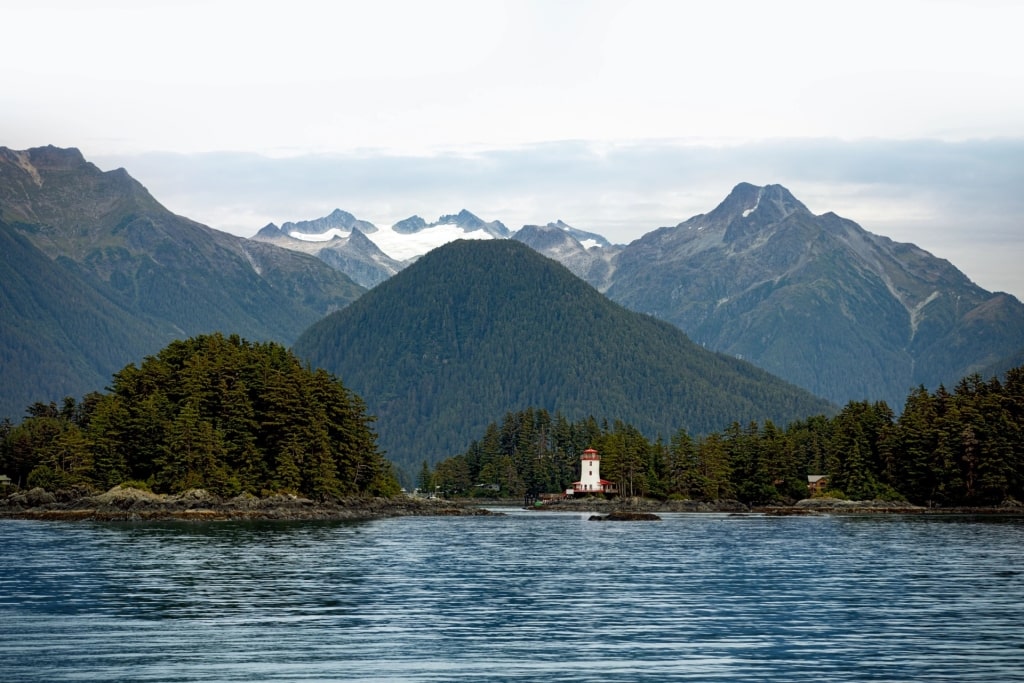
Sitka
Sitka is one of the best places to visit in Alaska. Here, you can explore one or several of the region’s remote islands and their rich wildlife by boarding an expedition catamaran. On the way, the catamaran will navigate through the waters of Sitka Sound, where you’ll have multiple opportunities to see whales, as well as brown bears and sea otters.
Whale Watching Excursions in Seward
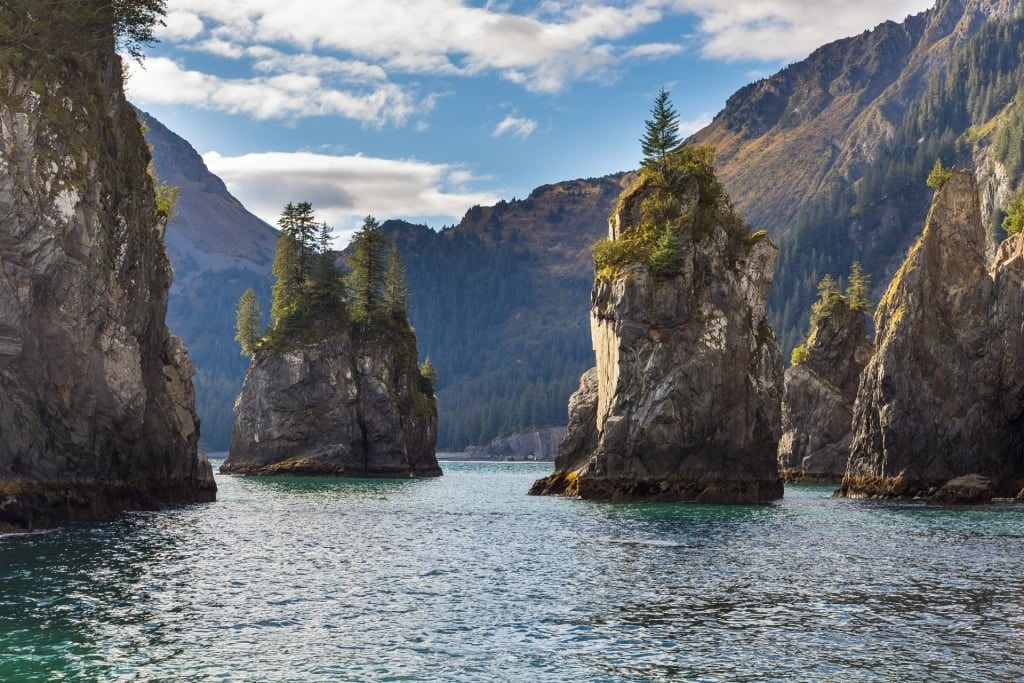
Kenai Fjords National Park
If you’re sailing on a cruise that ends in Seward, taking a catamaran cruise around Kenai Fjords National Park is a must-do in Alaska.
While you’re cruising your way through the waters of Resurrection Bay and Kenai Fjords, you’ll likely see humpback whales splashing in the water, soaring bald eagles, sea lion colonies, and puffins in the distance.

Infinite Veranda, Celebrity Cruises
Plan your whale watching adventure on a cruise to Alaska with Celebrity. Browse itineraries and book your dream vacation today.
